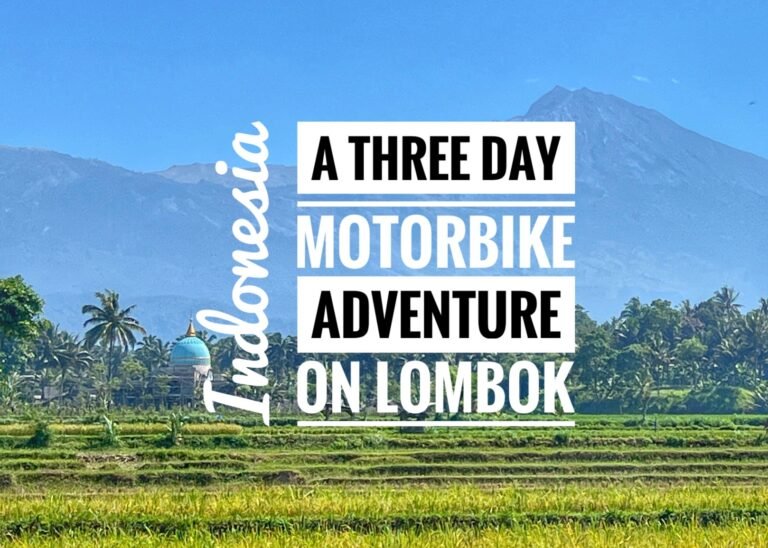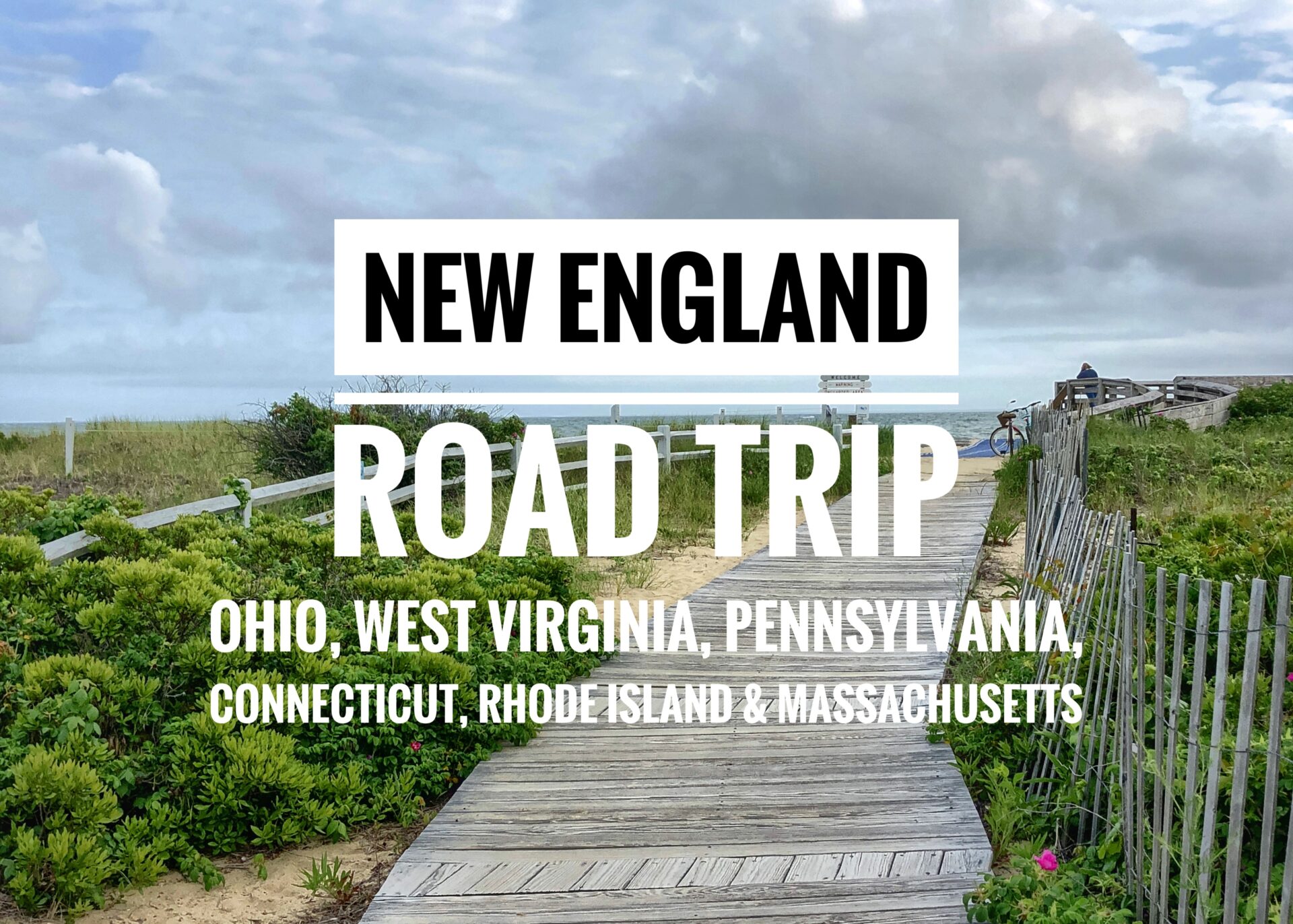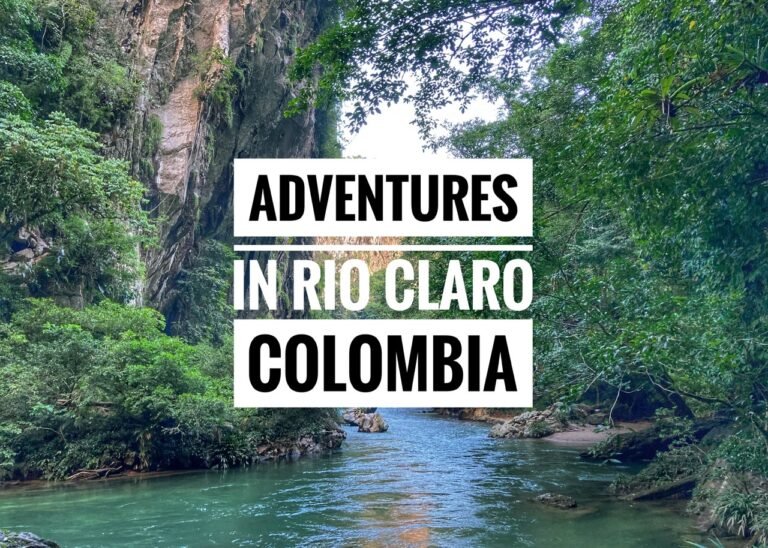
Arriving to Hue & Our Accommodation
After a very pleasant journey on the vintage railway, we arrived to the historic Hue train station at around 5 pm and caught a $2.40 Grab ride from the station to our apartment which bizarrely feels like it is dropped in France. Although it’s about a 25-minute walk to the center, it’s incredibly quiet and well worth it for the value we received. ($20/night)
In addition to a kitchen and private bath, at “Moon House,” we had a balcony and perhaps the best host we’ve had in Vietnam, Trang. (Although the competition is fierce.) She is genuinely hospitable and warm and provided us with a fruit basket, beers, waters and even ice cream pops. She then one-upped herself by running out to get us street food from the neighbors on the street below. What a treat!

The historic Hue train station is part of the rail network that threads the country from Ho Chi Minh City to Hanoi. It was built by the French colonial authorities during the French Indochina period (from 1898 until 1945). It is influenced by French architecture and considered to be one of the most beautiful railway stations in Vietnam. During the American War (Vietnam) and the Battle of Hue, the station housed snipers but U.S. troops drove them out. (Wiki)

In other French architecture, welcome to our apartment complex. It’s truly strange to look at this view from our balcony.
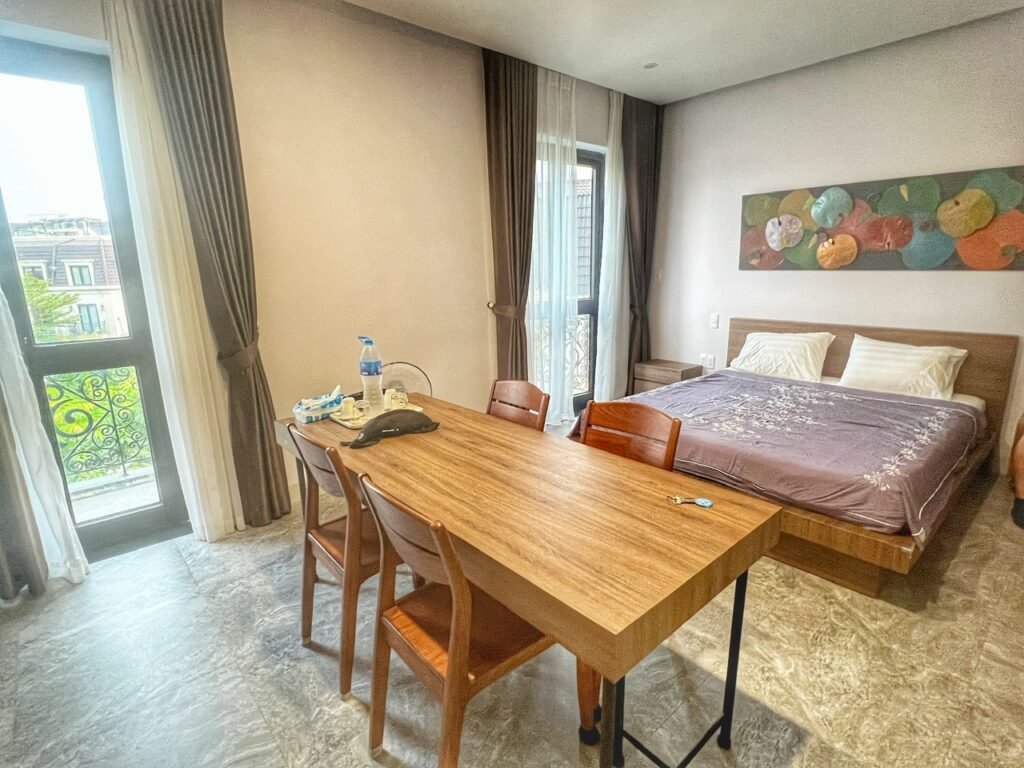
Inside the unit, we had a comfy bed, kitchen/work table and of course, obligatory air conditioning.


And we also had a properly stocked kitchen, which is like finding a gold nugget these days in the Airbnb pickings. Our bathroom had an ENCLOSED shower, no picture window to the window and a washing machine.
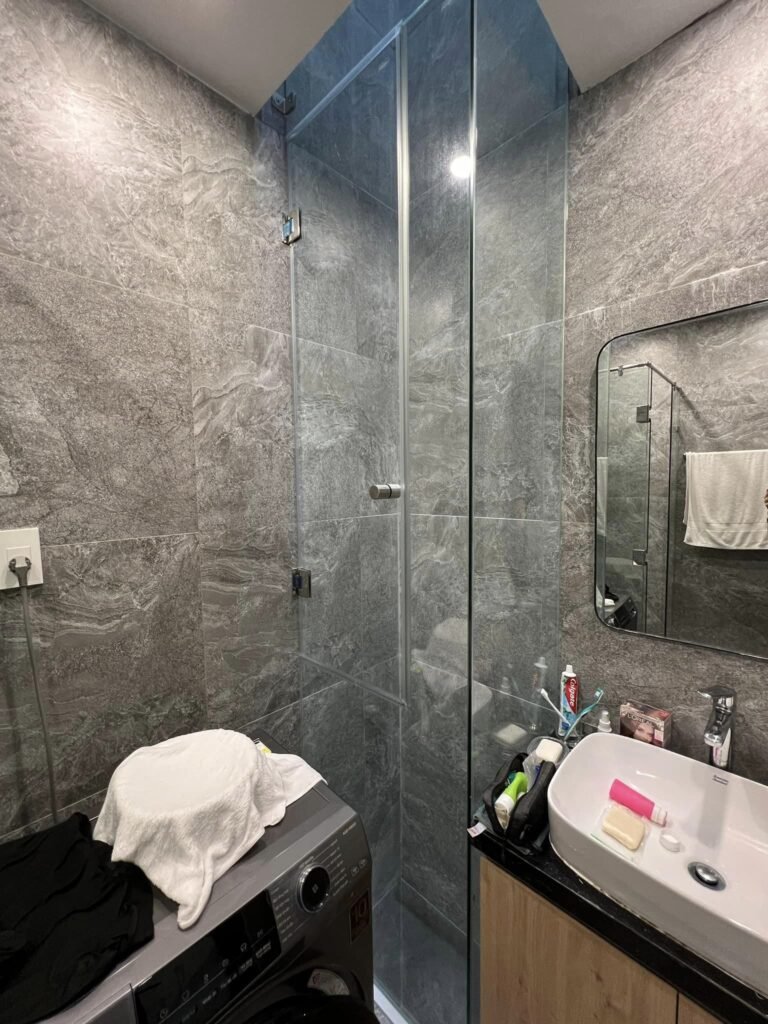
However, we also had a funny glass shoot which allowed the steam to escape to the roof, along with the apartments above and below us. This is a bit peculiar because you could hear the showers and toilet noises emitting from other apartments. And since we were no longer in Japan, there’s no “privacy” white noise button on the toilets here. Thus, one should poo at his/her own discretion.

Trang running to the neighbors for some street side goodies for us.

She brought us back BÁNH BỘT LỌC CHAY, which happens to be the veganized version of the traditionally chewy tapioca dumplings that originate from Central Vietnam. The neighbors typically serve them with pork but it was a Buddhist holiday which means it was a veg only day! Perfect! And yes, they were delicious. 🤤

Trang, our hostess with the mostest!
Imperial City of Hue
The UNESCO World Heritage site of the Imperial City of Hue was the capital of unified Vietnam from 1802 to 1945 and where the political affairs and daily activities of the court occurred and the family of Nguyen Dynasty emperors resided. It was significantly destroyed by the French Indochina War in 1947 when the Viet Minh seized the citadel. A French counter-attack besieged the city and a 6-week battle destroyed many major buildings and the Imperial Palace was burned. Later, in 1968 during the American War (Vietnam), the Battle of Hue continued to obliterate it although US troops were initially ordered to hold shelling on the city because of its heritage (according to Wikipedia.) However, these restrictions were gradually lifted leading to one of the longest and bloodiest battles of the war.
Thankfully, it has gradually been restored to its original grandeur. Today…it’s an absolute must see while in Vietnam.

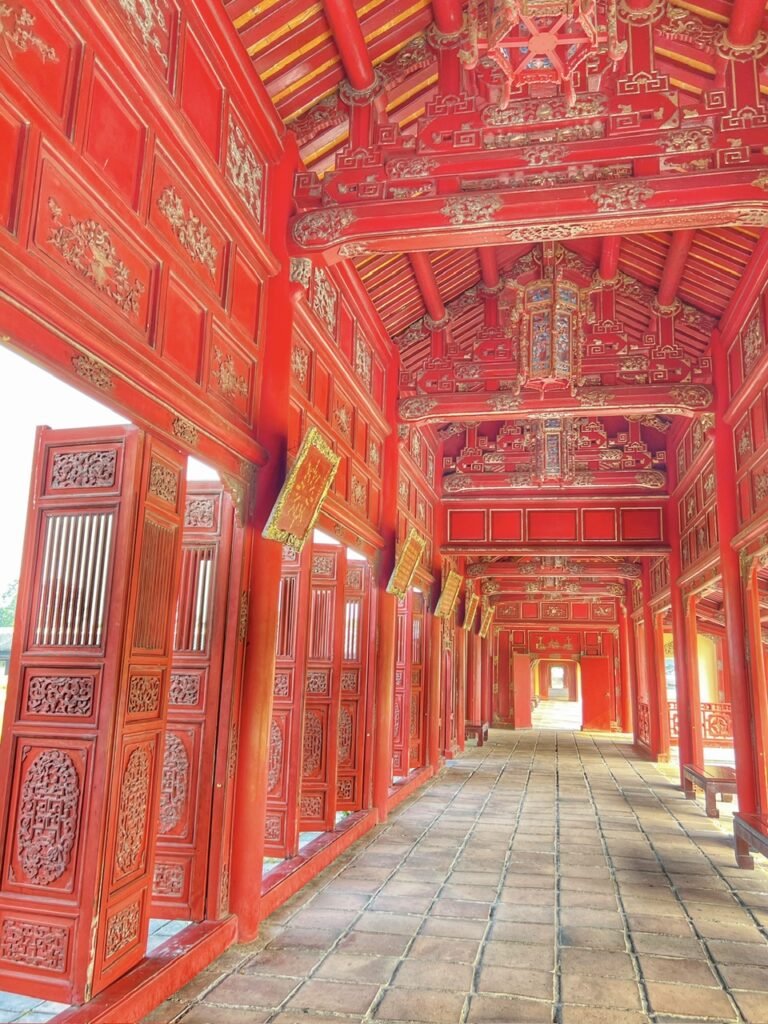
Although much of Hue’s original charm has since vanished, it’s truly remarkable that they were able to puzzle back together the Imperial City itself. With its incredibly intricate details, it could not have been an easy task.
It was designed during the reign of Gia Long, the first emperor of the Nguyen Dynasty (a last name that 39% of people in Vietnam have today, according to Heritage Line.)

We thought the Kiến Trung Palace was by far the most striking edifice in the complex. It was the residence of the last two emperors and destroyed by the Viet Minh during the Indochina Wars. Reconstruction began in 2019 and was completed just at the end of 2023, making use early viewers. It was designed in an eclectic style mixing French, Italian Renaissance and ancient Vietnamese. (Wikipedia)
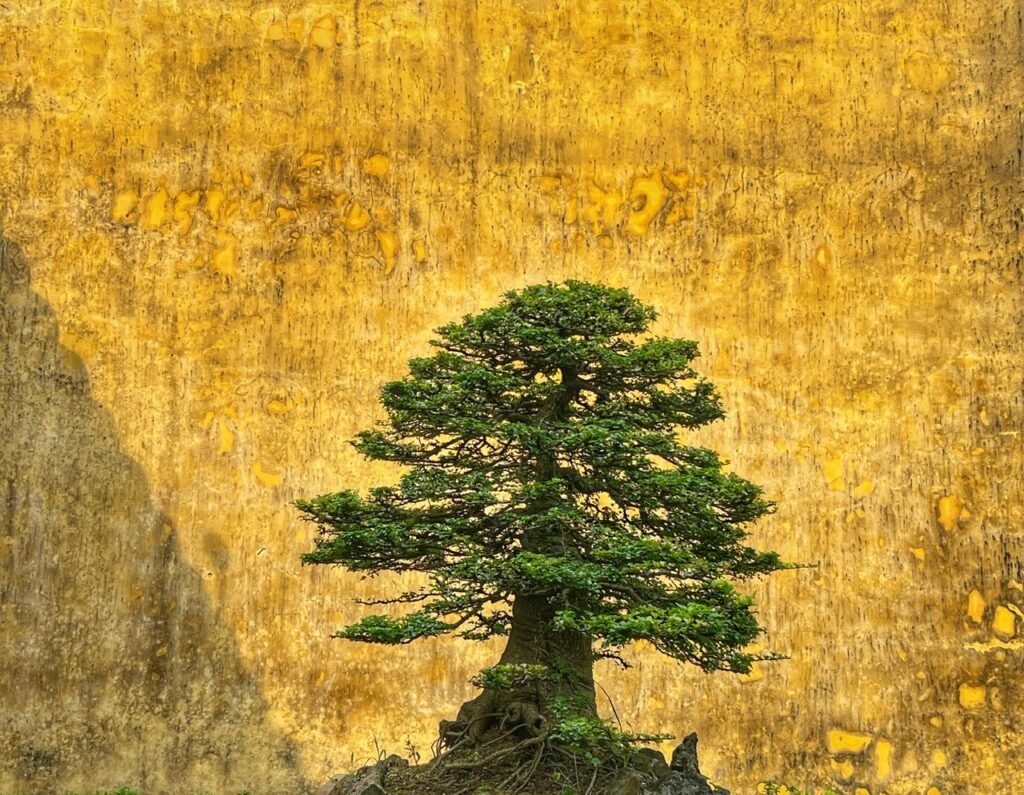
Walking the grounds of the Imperial City could easily take hours, if it weren’t a steam room outside, as there are so many beautiful sights to see. We found this bonsai tree against a speckled mustard wall particularly poetic.

One of four distinctive gates around the Imperial City, also called the Forbidden Purple City.

We left our apartment at 6:00 so we could grab some coffee and walk to the imperial city in about 45 minutes. The first thing we encountered before entering the exterior walled city is Ky Dai, or the stage of a giant flag and 19th Century monument, which doesn’t require a ticket to see.

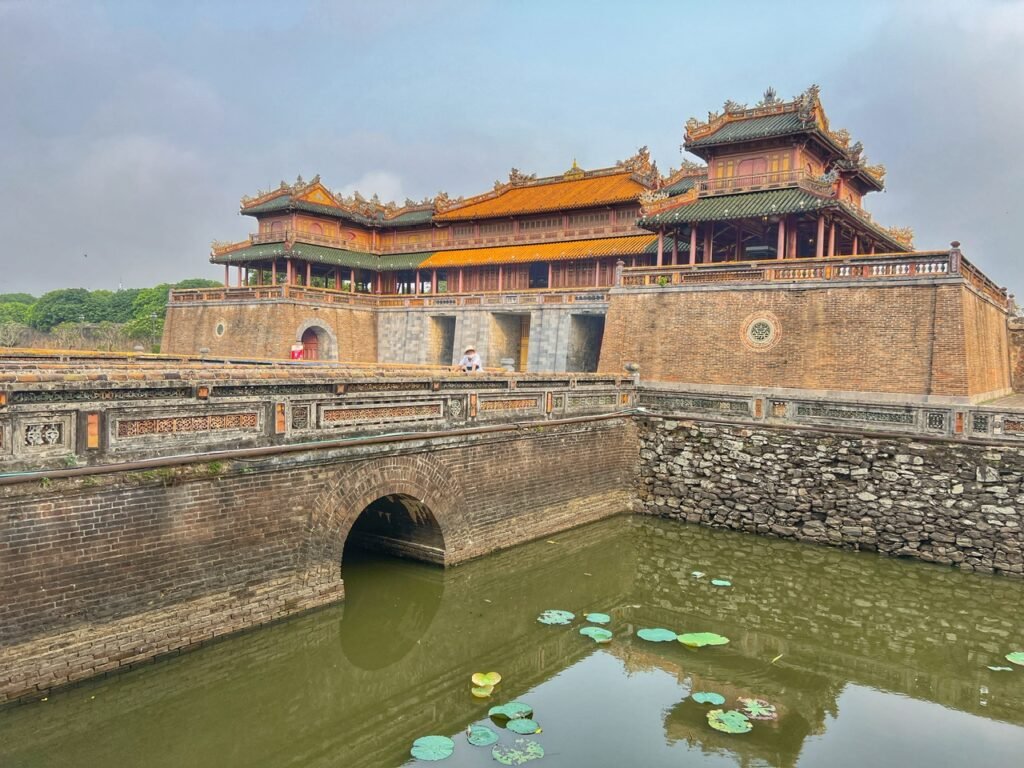
Teetering along the edge of an elevated narrow sidewalk, we walked through the exterior gate which apparently also welcomes traffic.
Veering left, we would soon encounter the main 1833 Meridian Gate of the complex, as well as the ticket office. We arrived to the site at 7 a.m. to ensure we were first to the ticket office when it opened at 7:30. Fortunately, it was already open and they let us in, helping us completely avoid any crowds and get a head start on the day’s soaring temperatures. The tickets to walk around the Imperial City are 200k Dong, or about $8/each, but to go in any of the buildings, it costs additional. We stuck with walking the grounds, which was more than enough for us.

Entering the massive complex of 36 Hectares (89 acres), we we happy to share it with only one other couple.
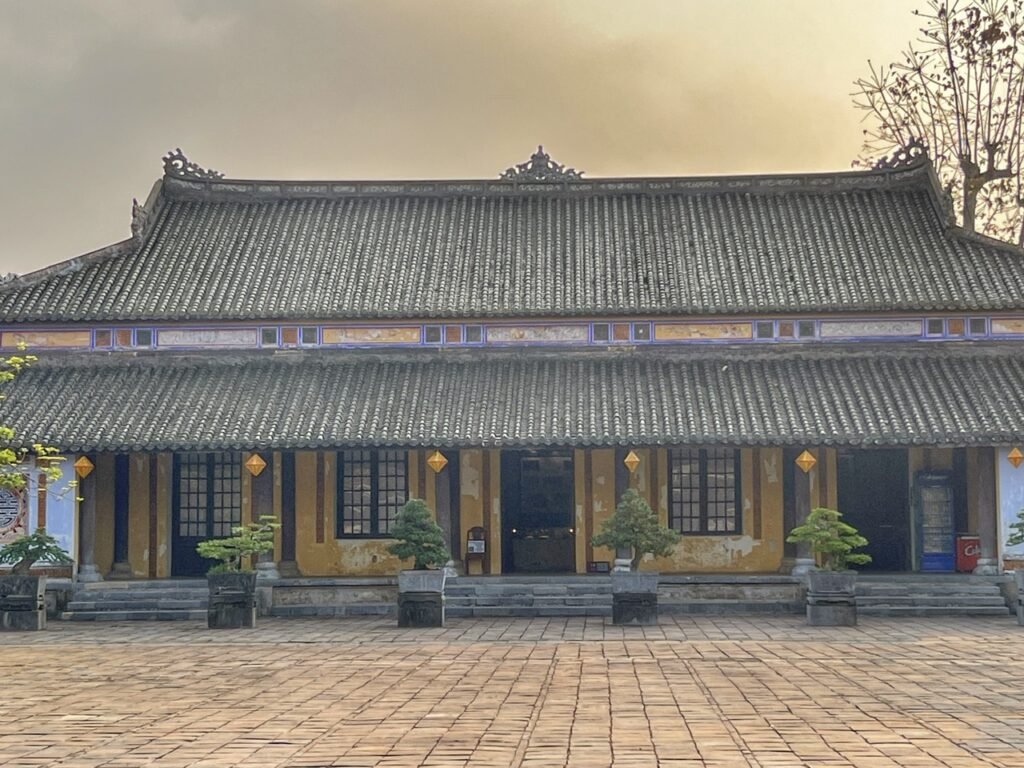
The Mandarin buildings were where the officials prepared themselves before regular meetings with the emperor, and they also served as administrative offices.

Nice waiting room, but where are the Prevention magazines?

It didn’t take us long to start noticing the intricate details on…everything!


Today, you obviously can’t visit the emperor here. But you can act like one and sit on his throne for about $5.25. If you want a couple of servants in your photo, they’ll be a bargain of $1.25/each. If you’d like to have additional people sit on the palanquin with you, they’ll cost a couple more bucks. Oh, the Vietnamese are quite the little entrepreneurs….everywhere we look.
From the Instagram reel of Emperor Khai Dinh on his palanquin, circa 1924.
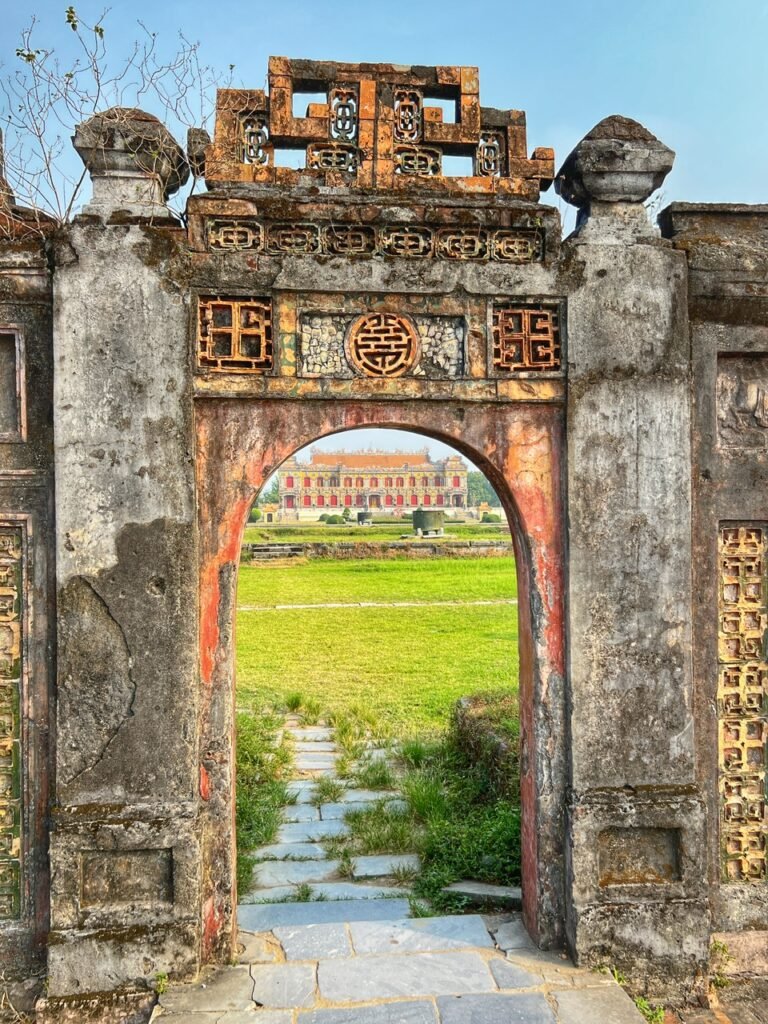

Coming through another walled section, we set our sights on the jaw-dropping palace for the first time. We were beyond grateful to see this virtually empty.

The lanterns down this shaded walkway were astounding.

A fish carved into the rock is a sign of fortune

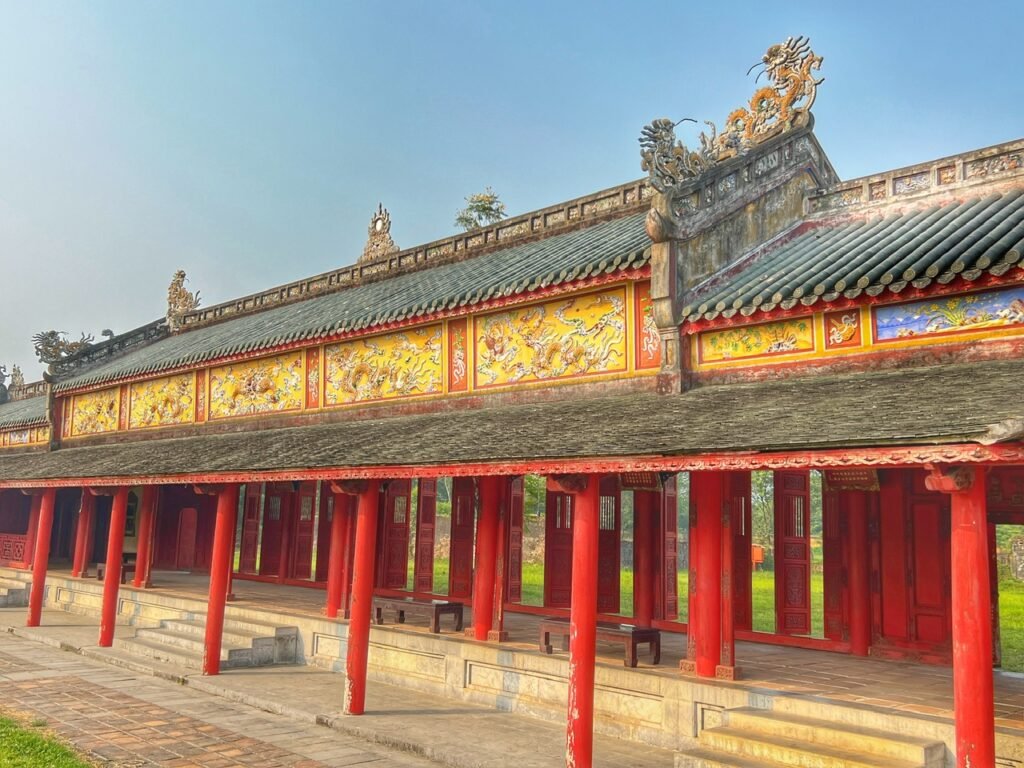
Photos from the outside of the walkway.

We then arrived to the palace…
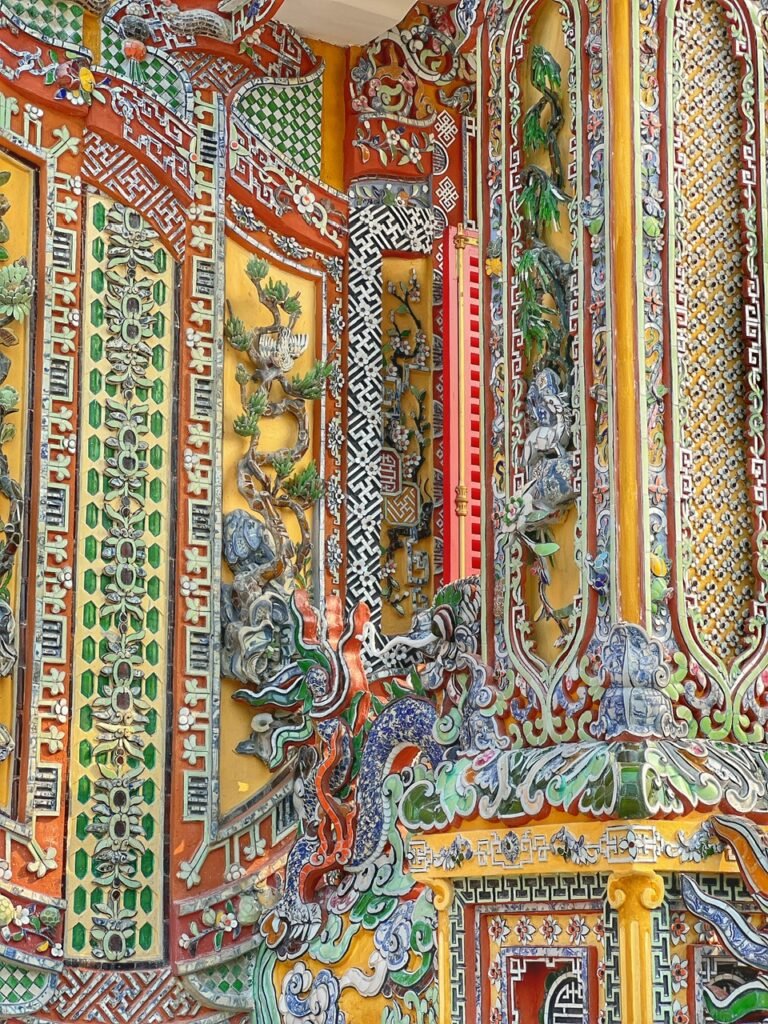


…where we were able to drink in the exquisite 3-D details up close. We’ve never seen anything like it. If you zoom in, you can see the way the vines and flowers emerge from the wall as if they’re real.

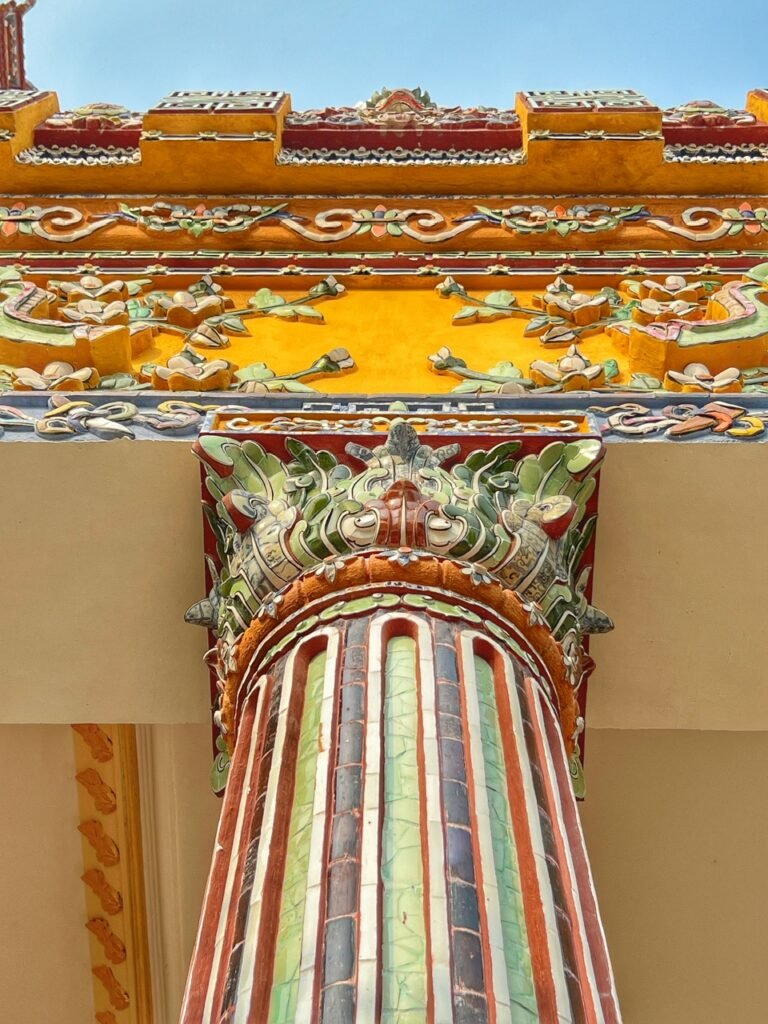

Each section was carefully laid with shards of glass, tiles and porcelain in an absolute mosaic masterpiece. Truly….just wow!!!

We got a small glimpse inside the palace by peeking into the entrance before an attendant came to collect.

Another gate to the exterior section of the city.


We then wandered into the garden sections of the complex, which offered meandering moats and bridges before arriving to Ngoc Dich Lake and a view of the Thai Binh Lau, or Reading Room.


Within this section, we saw many buildings that hadn’t been restored just yet.
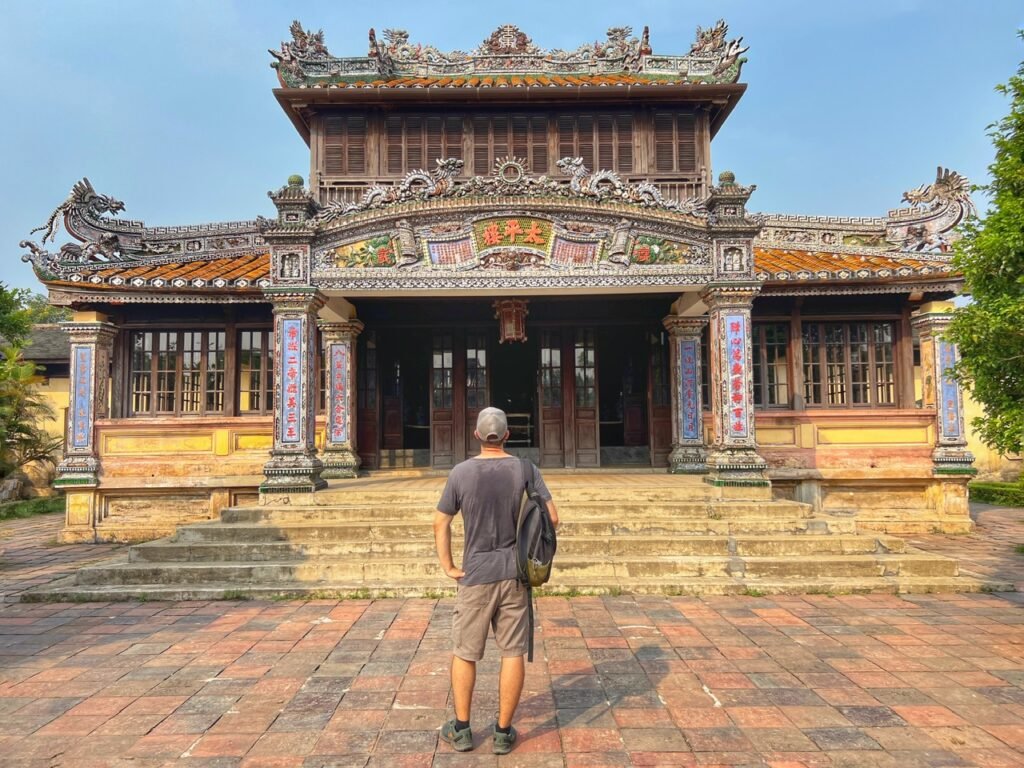
The Thai Binh Reading Pavilion, or Emperor’s Reading Room was constructed under Thieu Tai in 1841-1847. That’s quite a library. Hope they have WiFi.
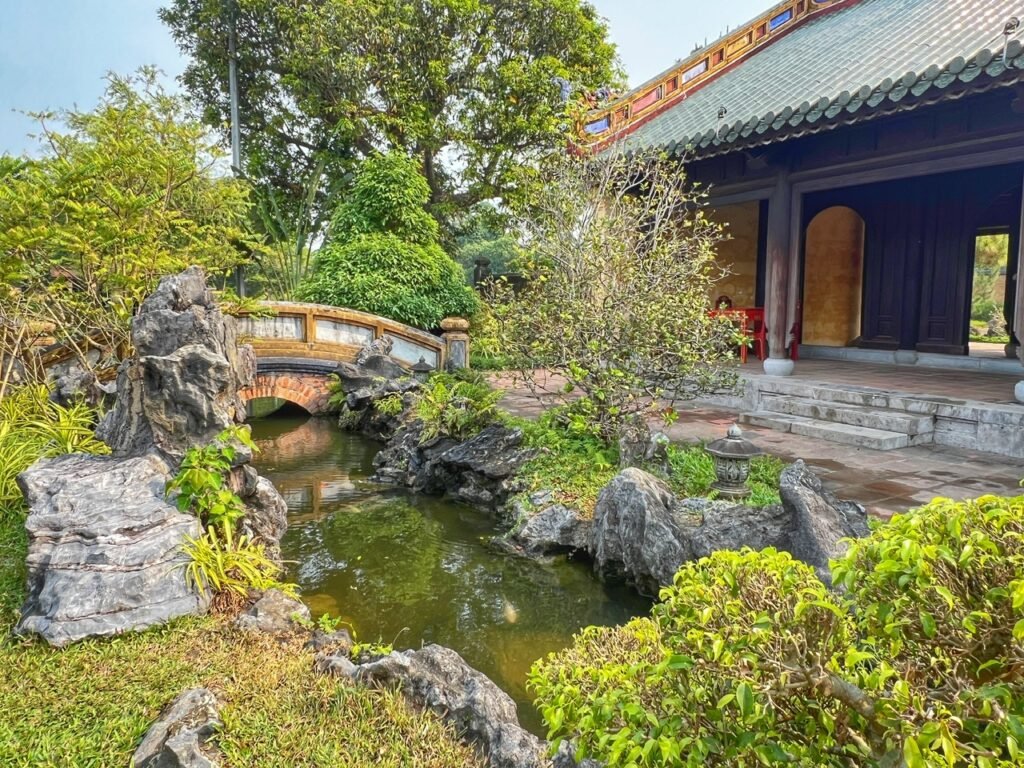
It is distinguished by artistic Japanese-inspired landscaping and unique pottery mosaics and today contained a gift shop.

By this time, it was 8:15 and the temperatures were already sitting at a 100F (38C) heat index and ticking up rapidly.
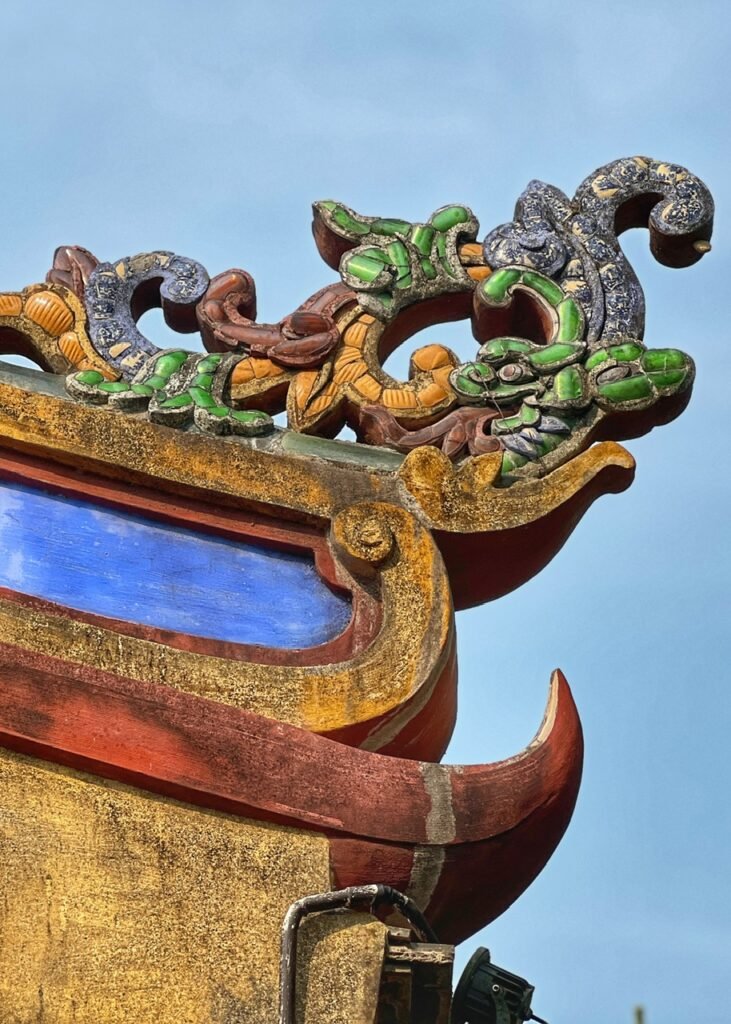


Although we were beginning to find slicks of perspiration, there was still so much to see….

The poetic bonsai from the first photos behind Mandy served as a perfect place to rehydrate and reflect.

These people really know how to do lanterns. Much better than our construction paper version in elementary school ![]()
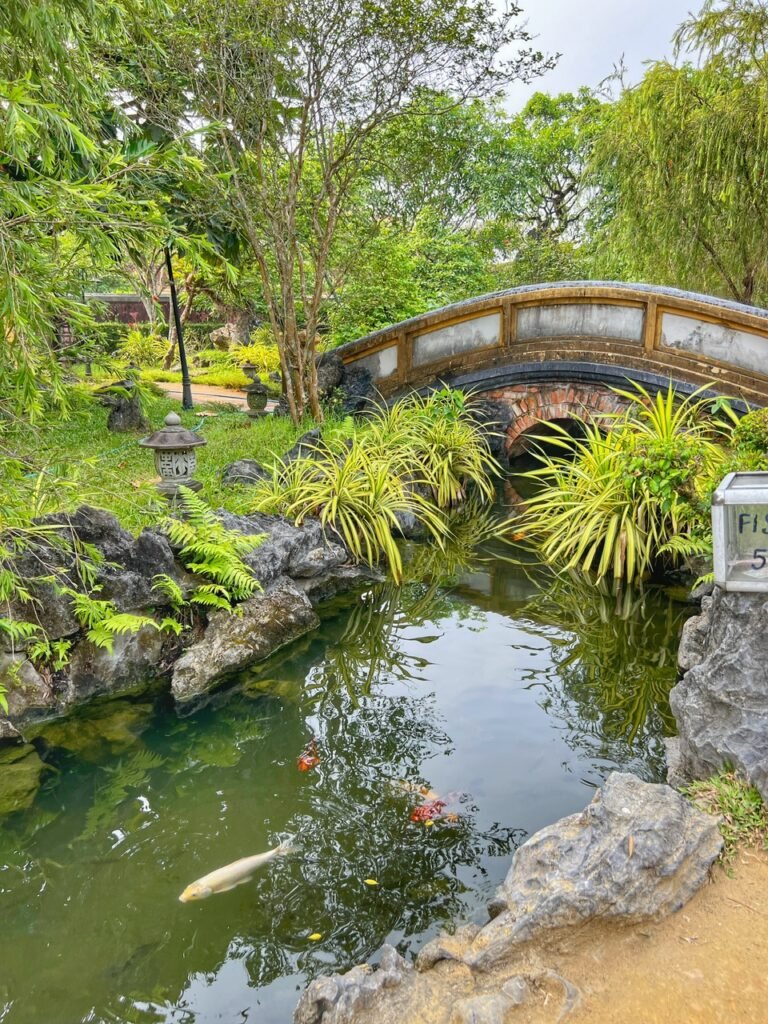
These tranquil sections felt like we had returned to Japan.
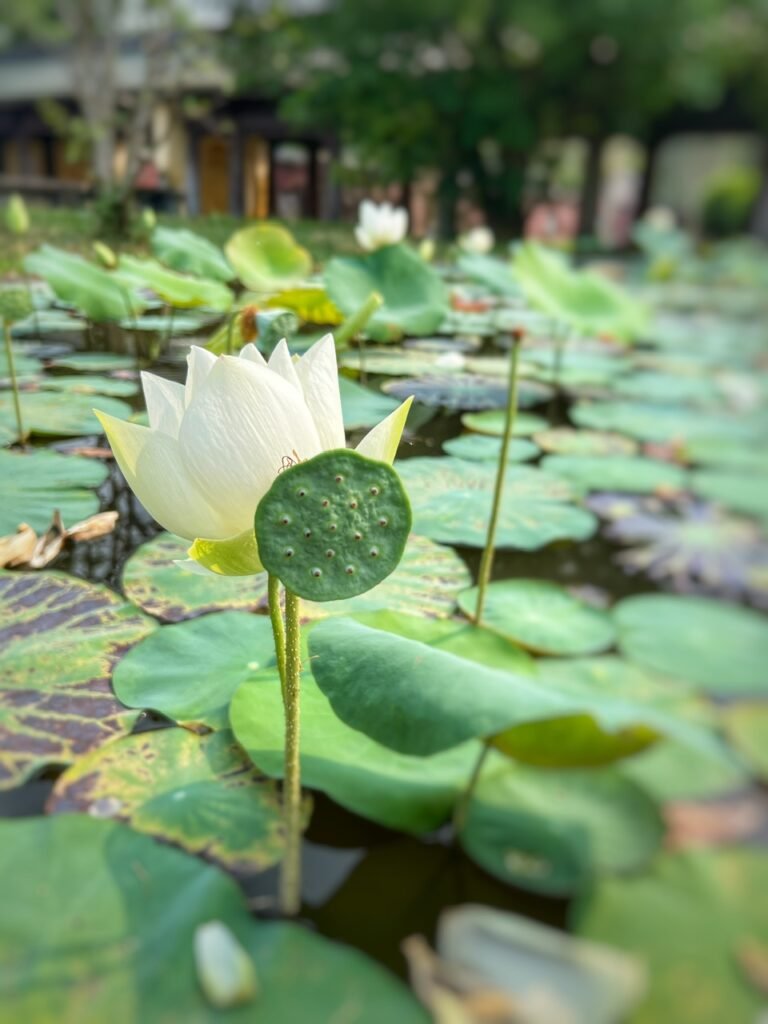
Love the way lotus seed pods look like mini shower heads

By the time we got to the Van Minh Palace, the tour groups were starting to trickle in.

The Duyet The Royal Theater dates from 1826 and was used for performance of classical operas.

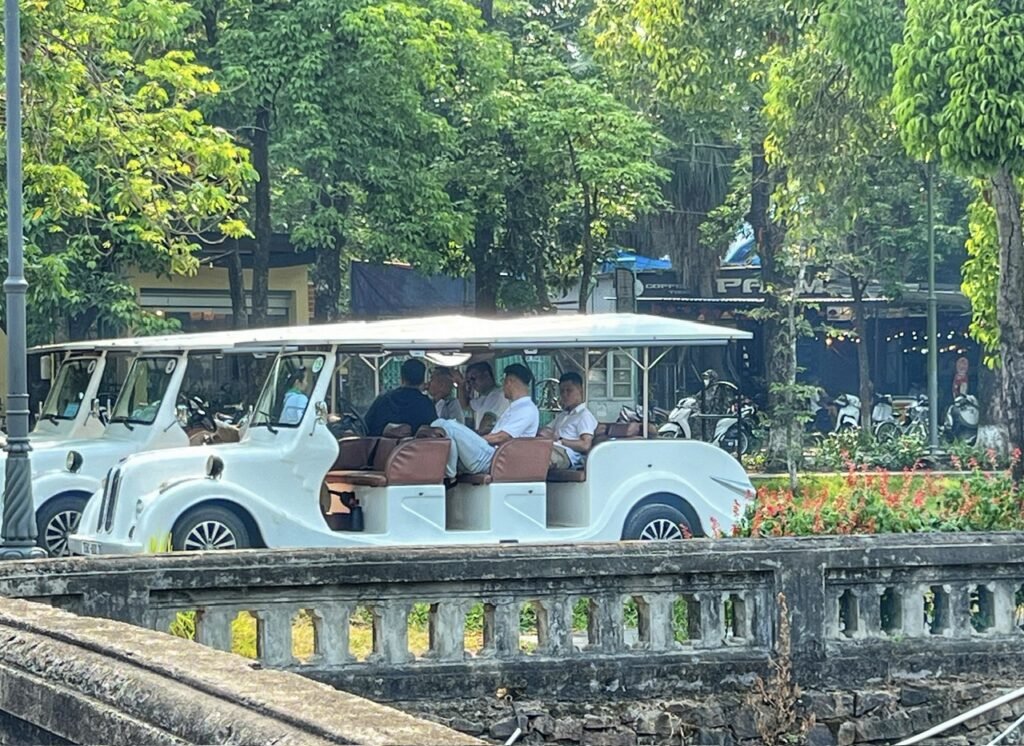
Upon arriving back to the main gate at 8:45, the white guys in Vietnamese hats had arrived as well as the Japanese girls in full undoubtedly sweltering Ao Dais for their photo shoots. We took this as our queue to exit, but then realized, we’d have to walk 400 meters back to the side gate. Normally this would not be an issue, but the heat index was now boasting 104 (40C) on it way up to 115 (46C).
Of course, the golf carts were waiting if we wanted them. We didn’t, but we have a feeling the Ao Dai girls would be needing them desperately very soon. Heading out, we were very happy to have woken up early!
Exploring Hue by Motorbike
We are realizing more and more that hopping on a motorbike is truly the best, most affordable and most fun way to explore Vietnam. In Hue was no exception. At 6 am, until we had to halt because the temperatures started to broil us, we created an exploratory itinerary which connected several of the perimeter sites which included dazzling ponds of pink lotus blossoms, the abandoned water park we posted yesterday, several emperor’s tombs, a colorful village of incense, an arena where tigers and elephants used to barbarically brawl and a Buddhist temple where Thich Nhat Hanh studied (a very famous Buddhist monk).
BONUS! Everything in this section was free! (Except the bike rental which was $4)
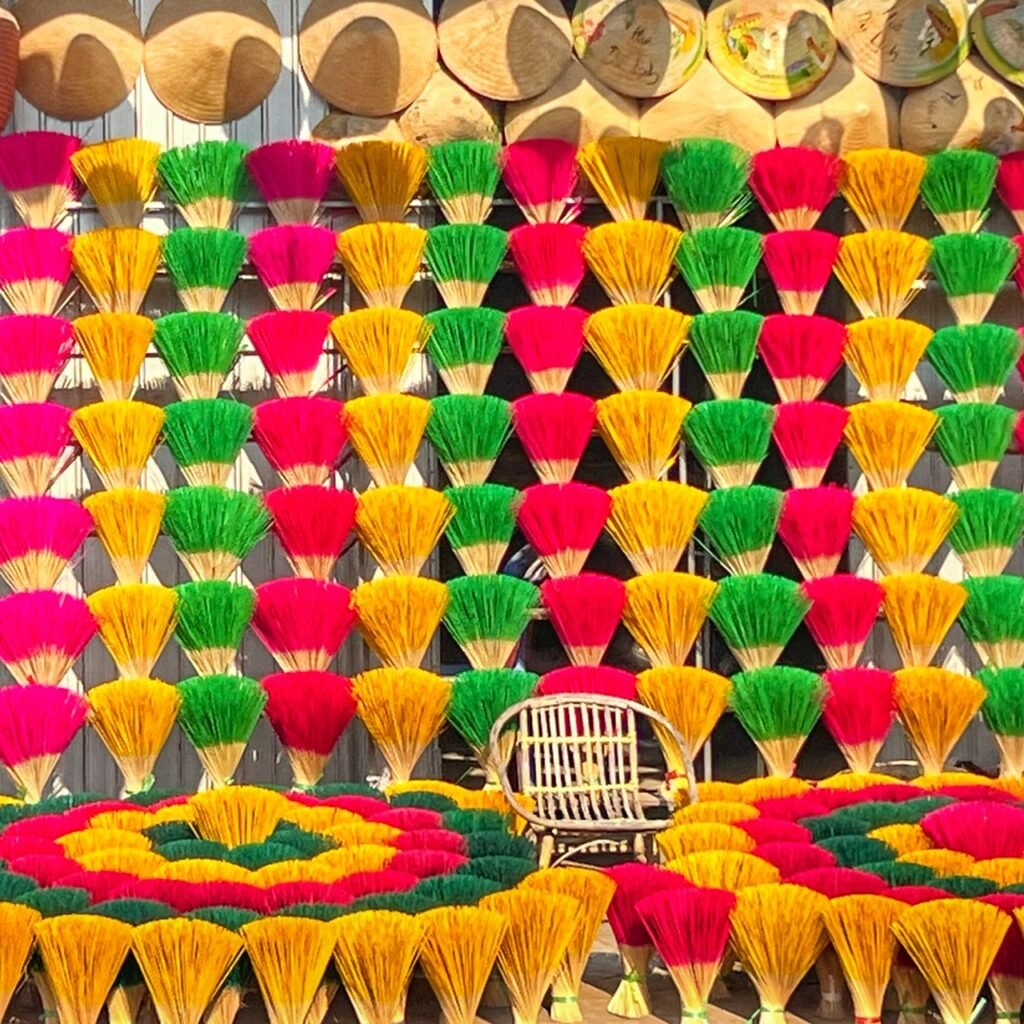
It was wonderful to get out in the countryside after the last month in cities. One such village we drove through was Thuy Xuan which is supposedly known for incense-making but more currently known for Instagrammers. But I’m guessing this photo did catch your attention?
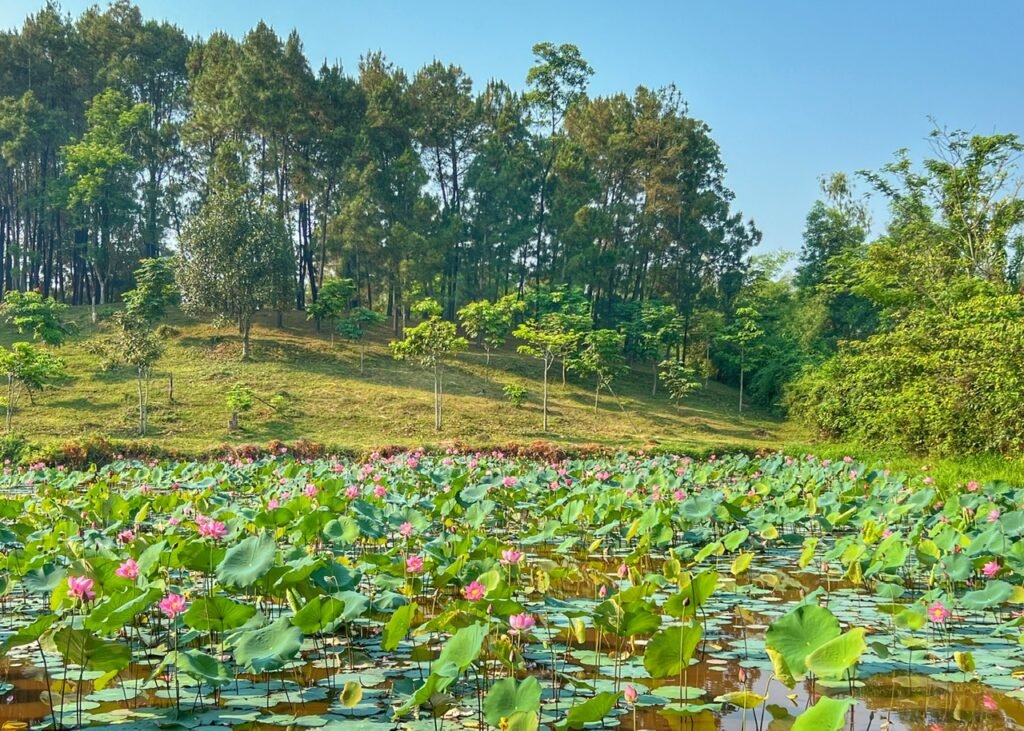
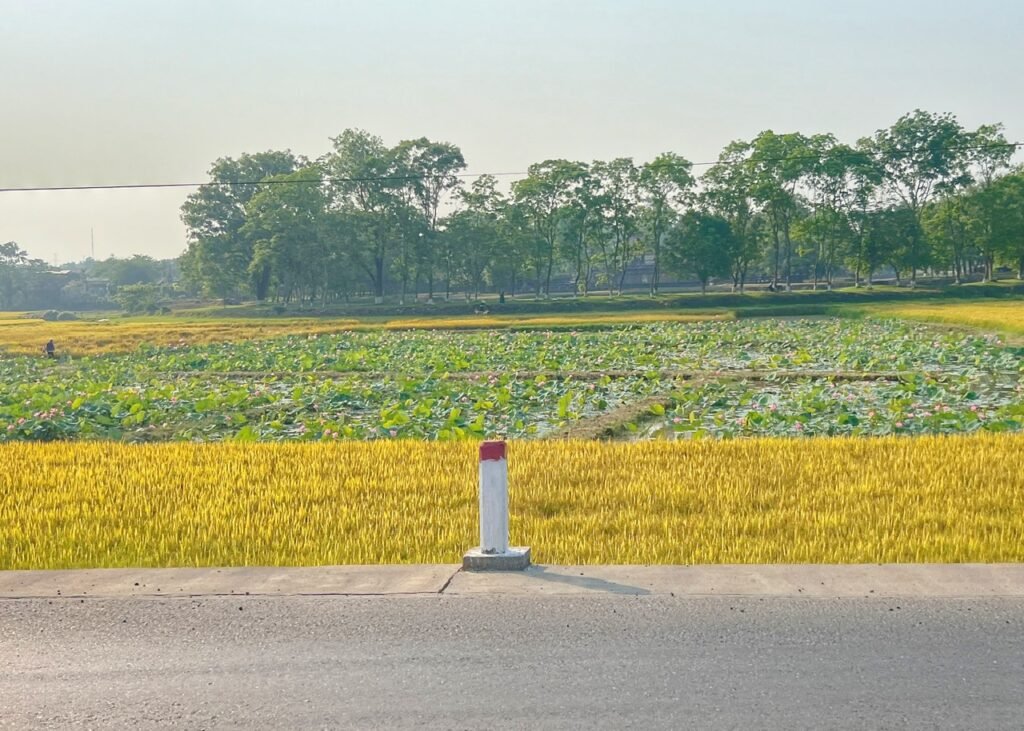
We personally found the countless pink ponds of blossoming lotus flowers much more striking, especially when surrounded by a sea of yellow rice fields.


Another stop was to Lang Tho Xuong, or the tomb of Emperor Tho Xuong. He must be a class C emperor however, because his tomb was not restored yet, nor was there a fee. We loved it because it was in the middle of an absolutely serene pine forest.

It was early Sunday morning yet there was still one man working on its restoration. The Vietnamese, much like the Mexican and Japanese people, are such insanely hardworking people. He seemed a bit surprised to see us there but was very friendly.

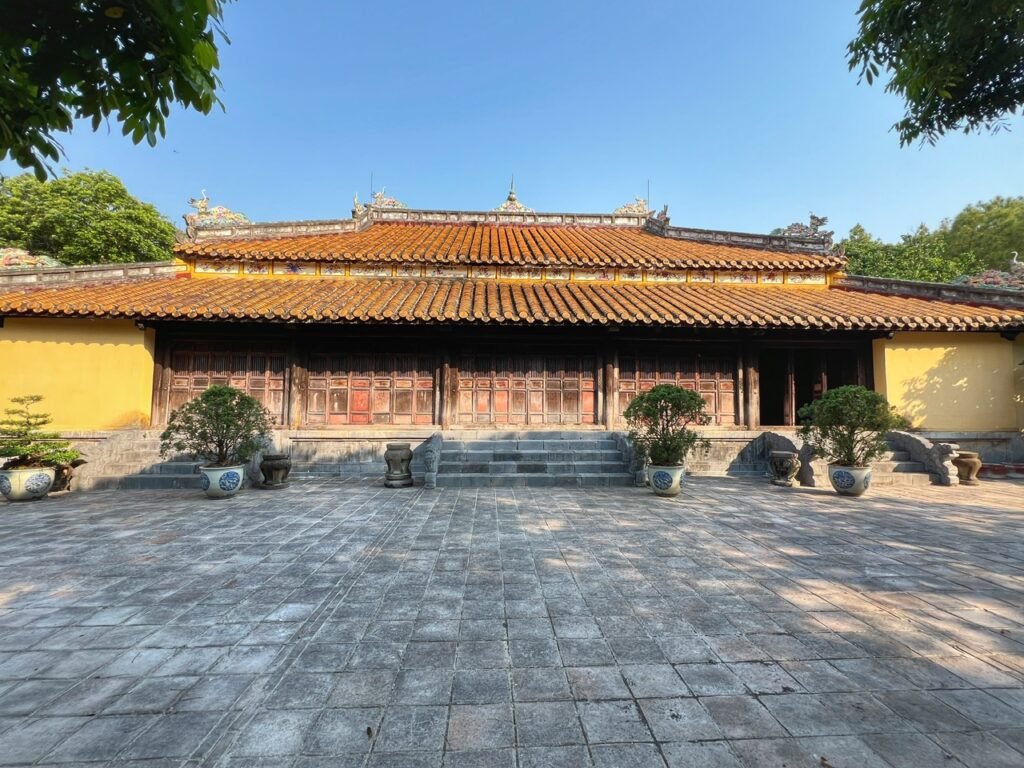
Badass biker Greg pauses in front of another nearby free tomb entrance, belonging to Thieu Tri (we think) who ruled the country from 1841 to 1847 passing away at age 41.


Inside the tomb were simple but elegant dark wood-lined corridors, and lots of pops of that fire engine red. The floor pulled it together aesthetically.




And again, strangely we were the only ones there…
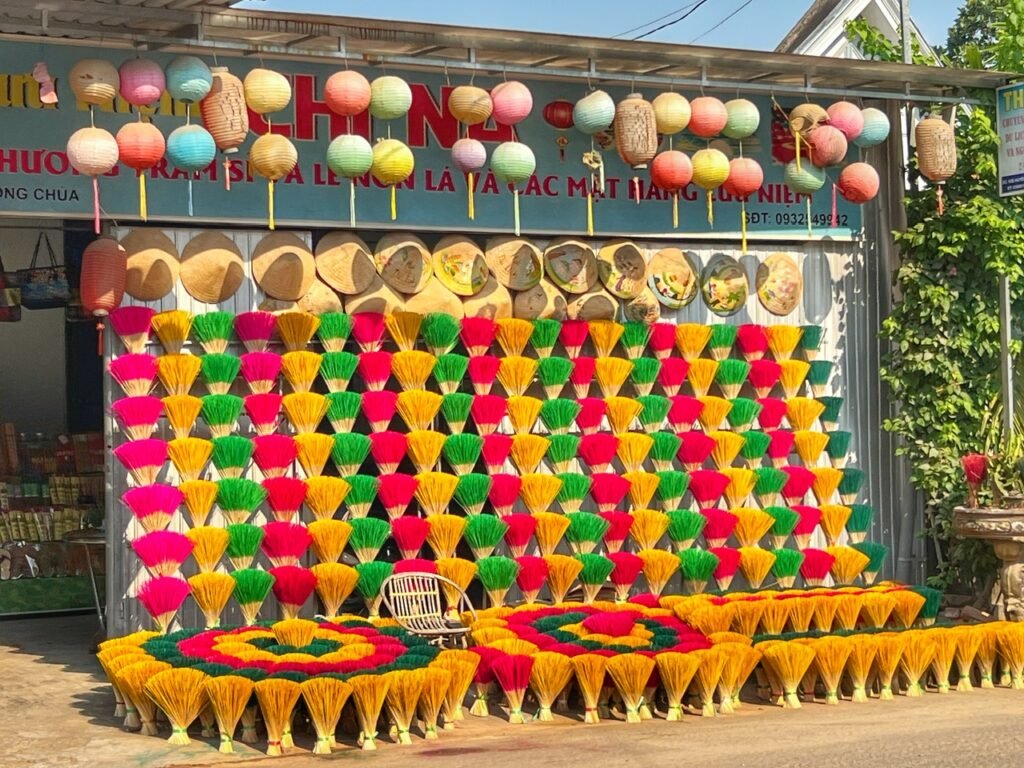

From here we scooted our way through the vibrant village of Thuy Xuan. To be honest, we’d heard Thuy Xuan today is kind of a tourist trap. The tours that head to the fee-based tombs stop here so visitors can take photos of the gorgeous staged incense.
The catch of course, is that the shopkeepers expect you to buy something in exchange for those photos. Fair enough. For those “influencers” (which by the way, please don’t call us that![]() ) who would like to do so, they can dress up in an Ao Dai and don a conical hat for about $2, which isn’t a bad deal amongst such Instagrammy backdrops.
) who would like to do so, they can dress up in an Ao Dai and don a conical hat for about $2, which isn’t a bad deal amongst such Instagrammy backdrops.
We rolled through at about 8, however, and none of this hoopla was occurring just yet. But the wisps of incense that permeated our noses from the bike did indeed smell quite nice!
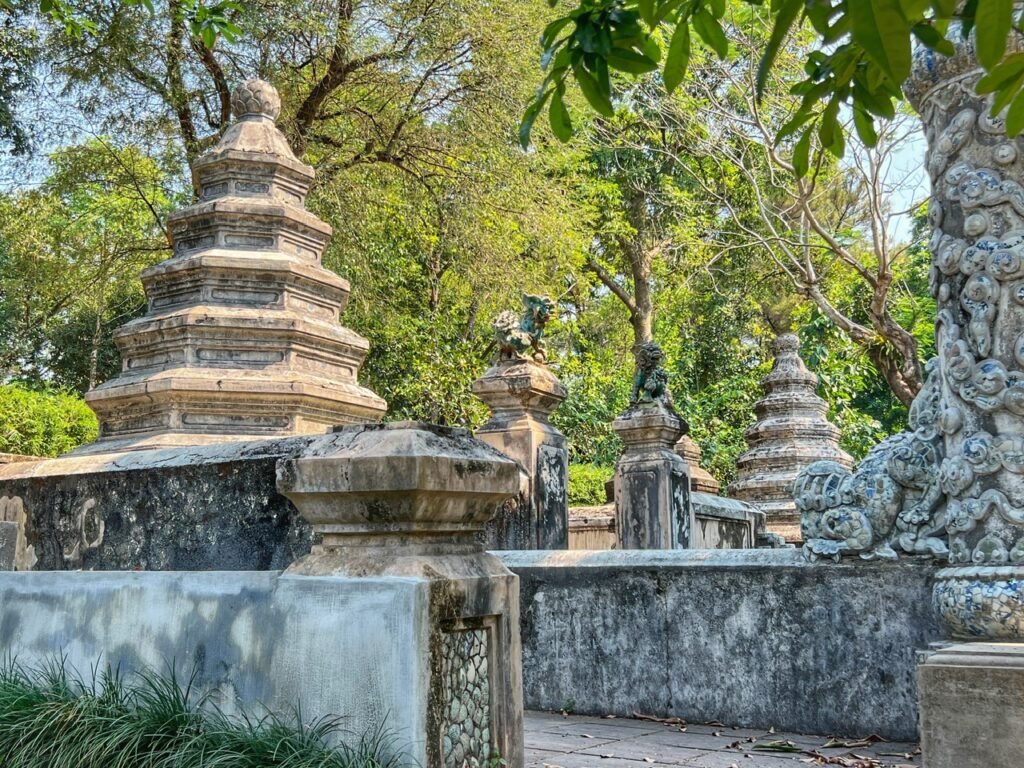
Moving along, we went to the also remote Tu Hieu Pagoda, a Buddhist temple renowned as a site where Zen Master (seriously want this title!) Thich Nhat Hanh studied.
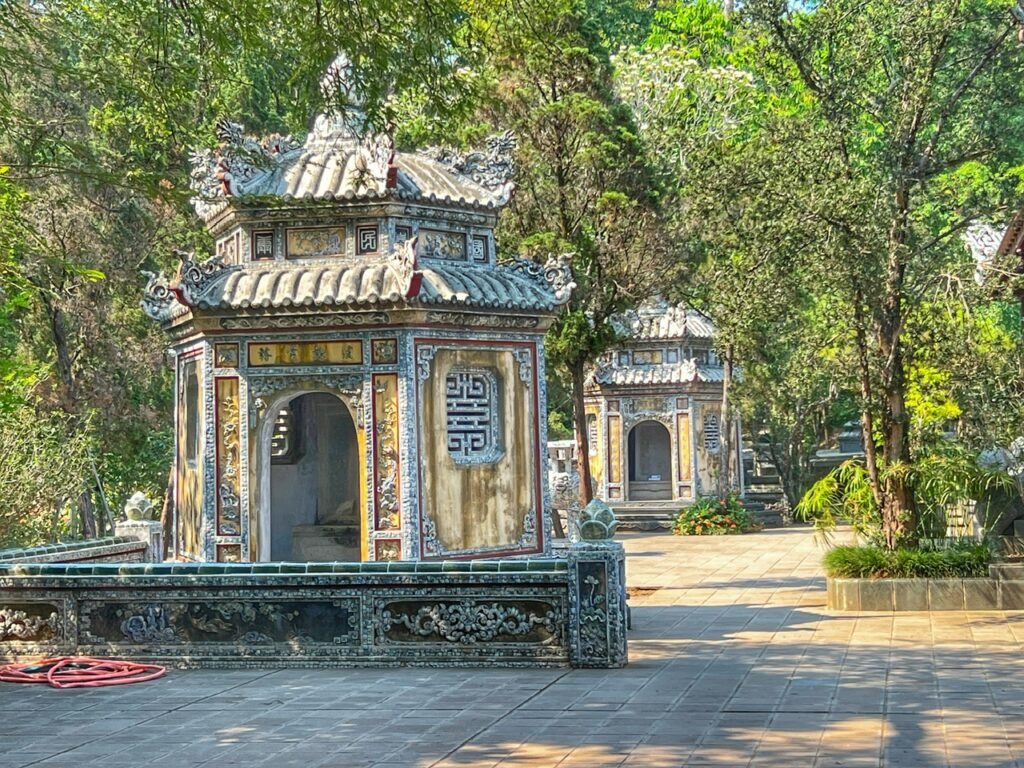

The crowd-free site was developed in the 1840s, and is still a working monastery today


It’s definitely one of the more peaceful and serene places we visited that morning, and if it hadn’t been heating up so much, we would have stayed roaming the grounds much longer.
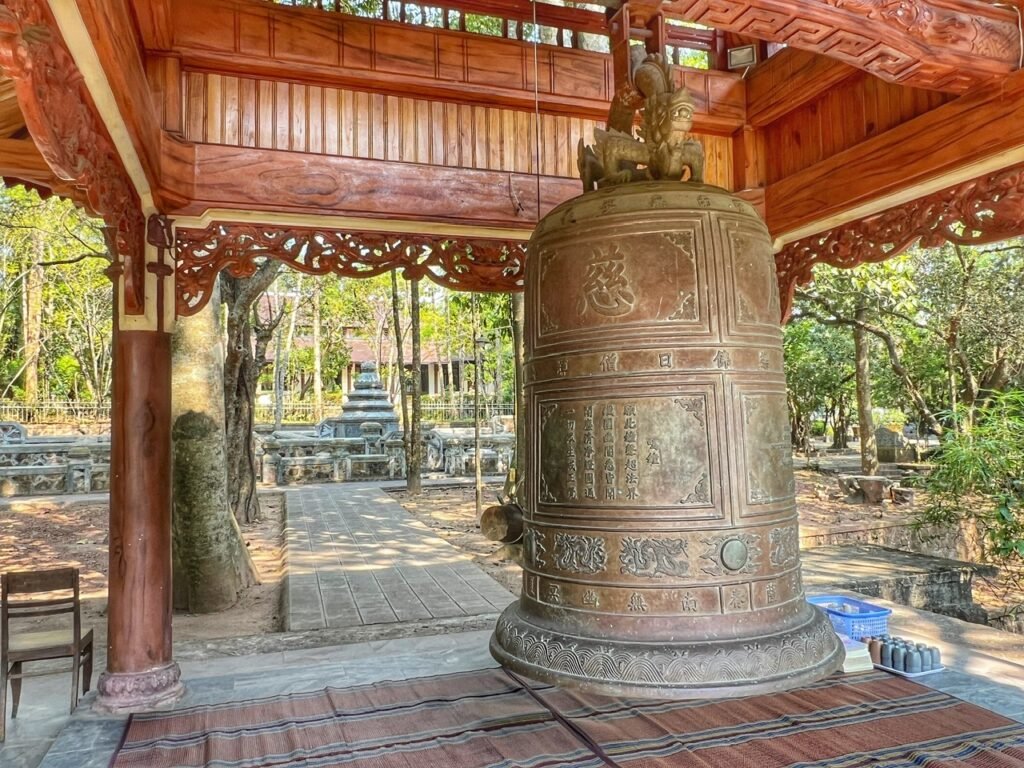
Now that’s a gong!! Don’t ring it! Don’t ring it! Don’t ring it!

A picturesque dock leading to an idyllic lotus pond.

The entrance gate to the grounds. We personally prefer the worn look even more than when they make it all restored and fancy.

Our last stop before we nearly melted was the Hổ Quyền, or Tiger Arena, a 16-foot open-air enclosure dating from 1830 where the emperor once held rigged gladiator-style games between feral tigers and imperial war elephants in training. If you thought Vietnam had bad animal ethics today, its history is simply appalling.


Yes, they defanged and declawed the tigers giving them no chance of winning, serving as training for the elephants and bonus (!), also royal entertainment until 1904. 😢 At the site, today you can no longer peer in the top part, but you can see the cages they would keep the animals in until the fight began. This smaller one was probably the tiger cage, while this was the elephants’

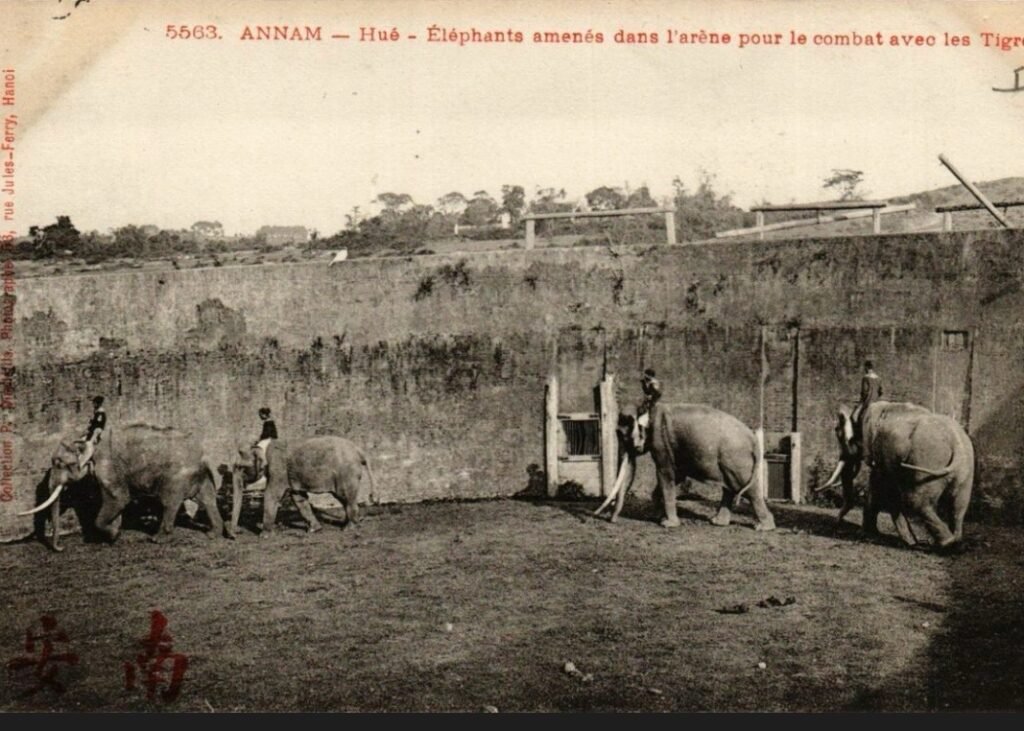
(Photos courtesy of Atlas Obscura.) According to AO, “historically elephants and tigers were made to fight to the death and sacrificed to the gods during a royal festival, and the records from 1750 state that the Nguyễn lords watched a most brutal battle commence on the Perfume River, where 40 elephants slaughtered a total of 18 tigers. The festival was usually held once a year, and while its original purpose was to train the imperial war elephants, it later developed into a form of royal entertainment. Sometimes, there were incidents in which the emperor or his courtiers were put in danger. Once, a courtier was killed by an elephant after getting attacked by a tiger and falling into the fighting pit. In another instance, a tiger escaped the fight and came swimming toward the emperor, who managed to use an oar to repel the beast. Following such incidents, the Minh Mang Emperor ordered his people to construct an arena west of the Citadel in 1830, so that he and his men could watch the games safely.”
What a fascinating, and deeply disturbing, piece of history.
Ho Thuy Tien Abandoned Waterpark

This is also a great activity to include with the motorbike day!
Although the imperial city was remarkable, for us it was not the most captivating part of Hue. But then again, the off-the-beaten path quirky discoveries usually get our vote any day….In this case, it was Hồ Thuỷ Tiên about 10 km on the fringe of Hue. This deserted water park appears to be post-apocalyptic wreckage which is being succumbed to natural elements in a beautifully rhapsodic way. By the looks of it, one might think this dilapidation has been advancing for 20-30 years, but in fact it’s only been around a decade….
It was opened to the public in 2004 at a price tag of ~$3 million USD when it was only partially completed and bankrolled by Company Hue Tourism, according to Atlas Obscura
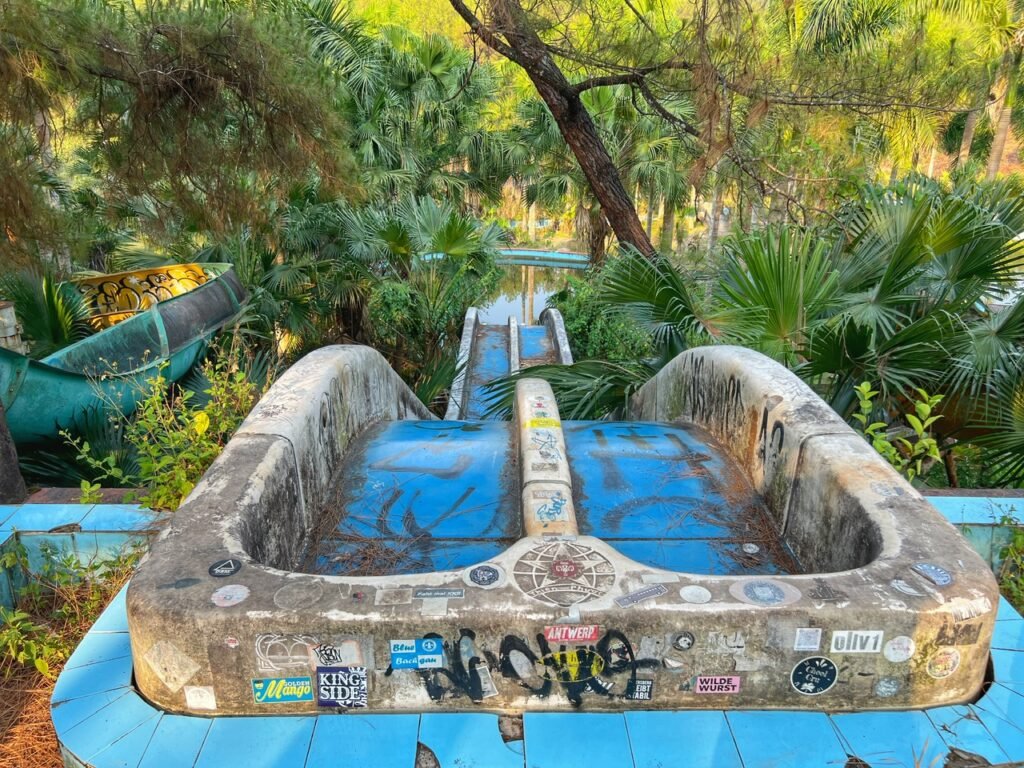
The park gives insight to what could happen with some of the current kitschy and vacant hospitality creations we’ve seen throughout Vietnam.


In its prime, kids of all ages were undeniably drawn to the park’s iconic beacon…a three-story dragon which featured an aquarium where manta rays, sharks, crocodile and fish lined the walls of the interior staircase, built to resemble a dragon’s rib cage. (AO)

Apparently until very recently, the (#real) crocodiles also rivaled the (#fake) dragon for attention as they were let loose in the lake upon the park’s demise. According to our Atlas Obscura app, backpackers saved the day. “After repeated calls to WWF and PETA, the Vietnamese government finally transported them to a proper wildlife park.” It then warns… “Still, it seems best to avoid all water in the park both for reasons of sanitation and potential rogue chomping.”
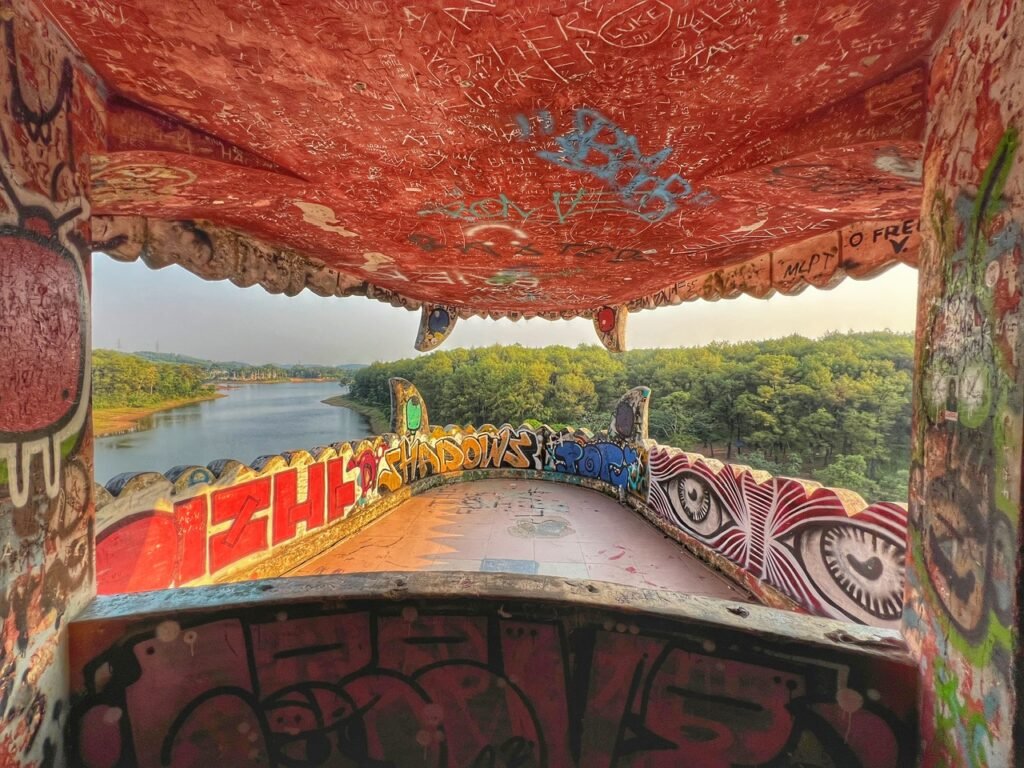
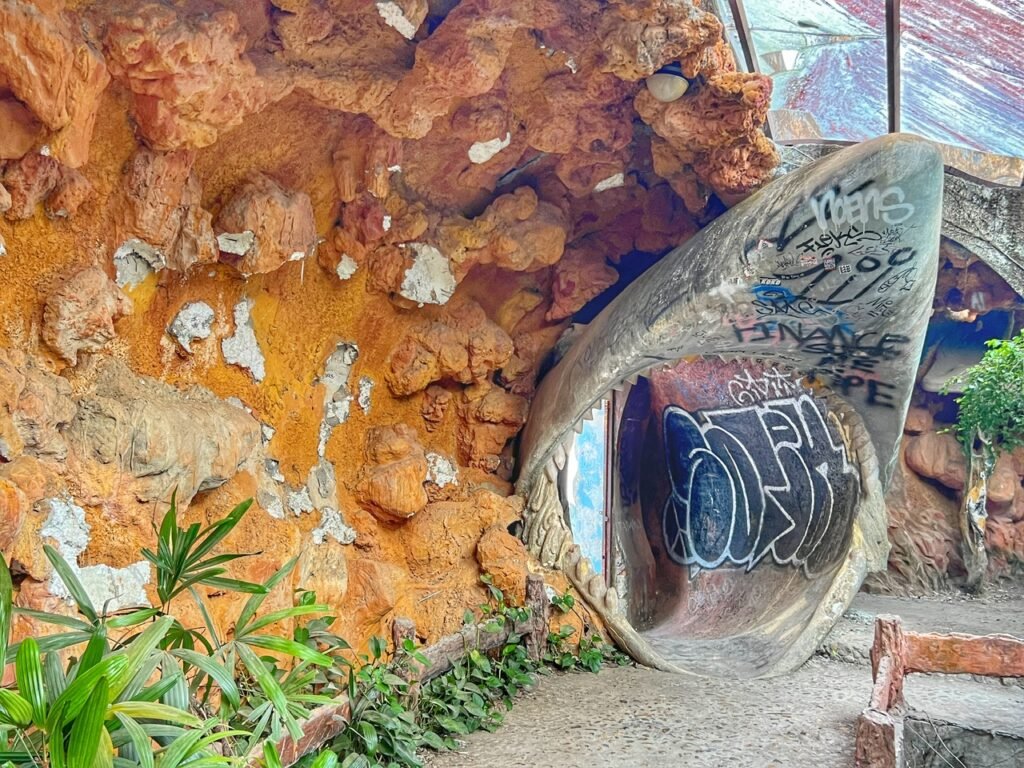
Today, if they can find the site, visitors can wander mindlessly without fear of becoming a meal, except by the jaws of the legendary dragon, and this sinister shark tunnel.
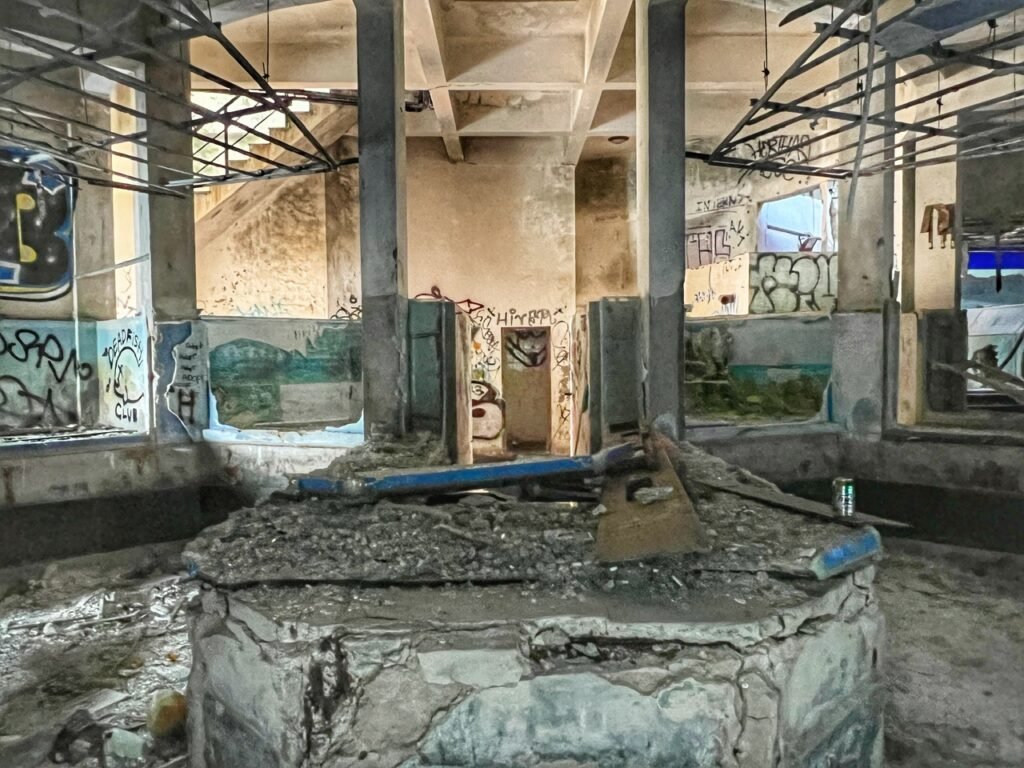
The underbelly of the dragon has turned into what looks like a war zone in 10 years. Unbelievable. Thus, to state the obvious, enter everywhere at your own risk.

A fierce claw buries itself into the platform, holding on for dear life.


To get to the slides, follow the walkway out the dragon’s behind to the forest, where you then walk 50 meters down a pleasantly wooded trail….

…until you stumble upon a derelict platform with three slides plunging into the jungle.
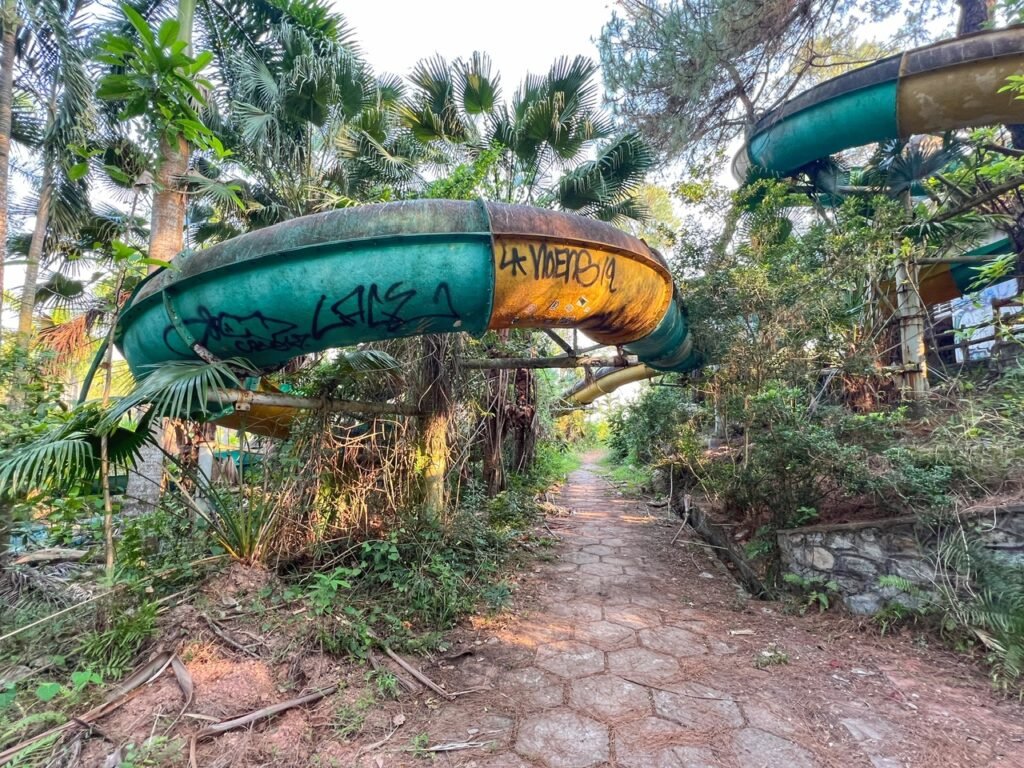
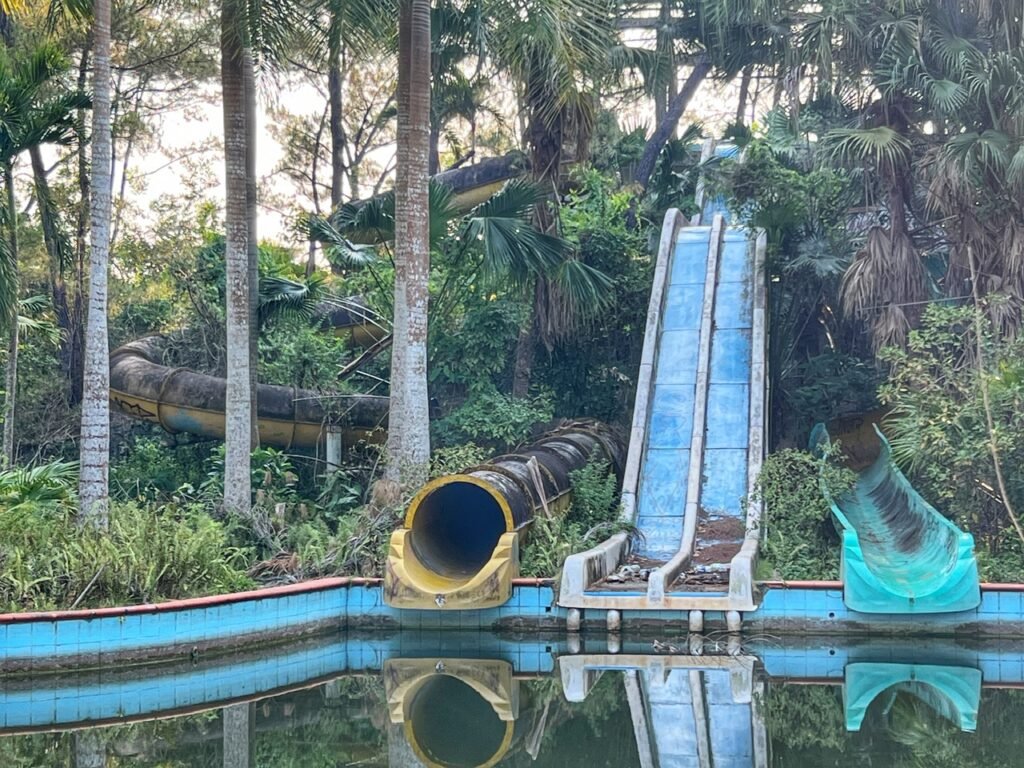
…a jungle which is happily eating them alive; as jungles tend to do. The takeover is elegantly eerie (and was surprisingly mosquito free!).
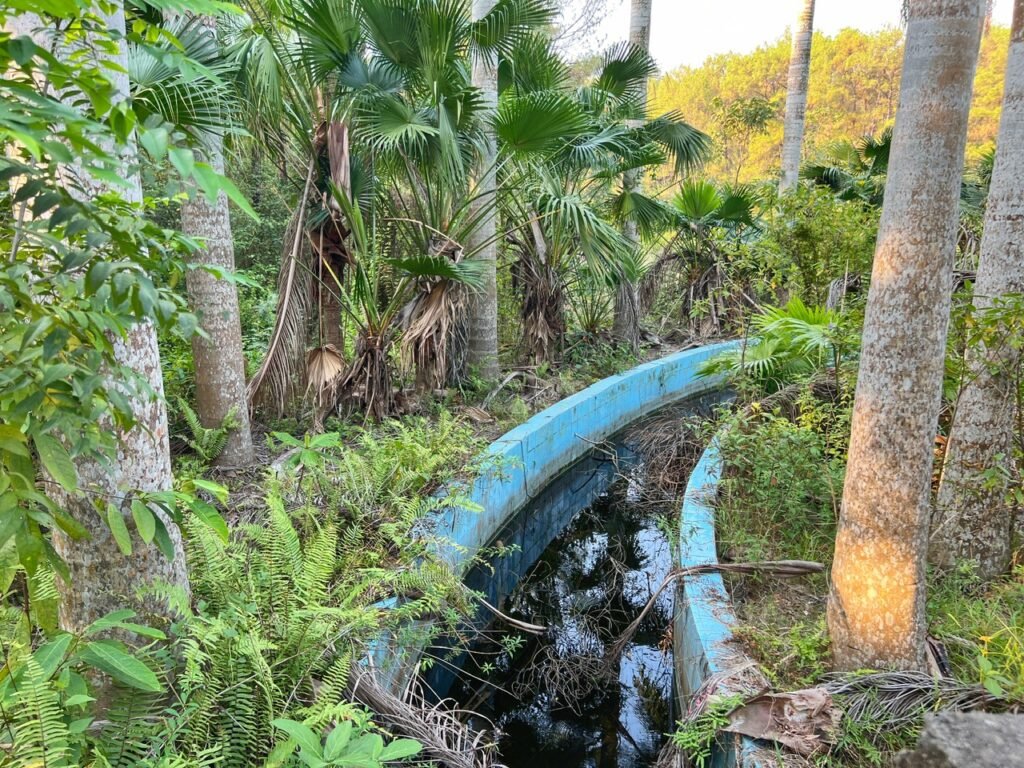
A lazy river winds its way under the platforms. This whole experience is something you’d never get to see in most countries and entrancing to witness.

The name of the park can be found on Google. We arrived by motorbike, which seems to be the best way to visit, to its entrance where an out-of-place Moai-inspired statue looms. Supposedly there is sometimes an opportunist local trying to collect money to enter the site, but there is no fee in reality. Even if there was, it might be well worth it….
Emperor Tu Duc’s Tomb

Hue, which means harmony, supposedly refers to the harmony of nature between the Ngu Binh Mountain and the Perfume River, which seemed like a perfect place for its former royals to call home, both during their time on earth and beyond. Today, an abundance of mausoleums coat the surrounding river, each one more extravagant than the next. So we had a choice to make in our limited time before the daily heat tsunami roasted us on our designated motorbike adventure “day” (4 hours in the morning.)
The tomb we chose to enter during our designated “motorbike adventure day” was Tu Duc’s, said to be one of the most beautiful of the Nguyen Dynasty, located 8 km from Hue in a rugged pine valley.
In his reign of 36 years, Tu Duc was an emperor who lived a life of excess and had 104 wives. He was also a ridiculously picky eater who demanded at least a dozen food choices for every meal which is why Hue’s cuisine is so diverse today. In addition, we read he required for his morning tea to be made with the dew from lotus flowers leaves. Wow, sounds like a fun guy to work for….
The tomb complex is undoubtedly a blend of Hue’s natural and architectural harmony, covering an area of 20 hectares of gorgeous nature and nearly 50 architectures constructed in groups at different heights. (Thua Thien Hue Portal.)



According to Lonely Planet, it is perhaps the loveliest of all the Nguyen tombs and certainly the most visited, which means unlike our previous post of freebies, it cost 150k Dong ($6). The interior of the complex looks like a large park, but it seems that many come here just for the photo opps.

For example, a whole throng of people crowded on this dock to take photos on these ladders (?) Why? Is this a notable spot we don’t know about?

An entrance to the complex

A glass painting and poem written by another emperor, Thieu Tri.


Royal thrones on which Tu Duc would nitpick his meals with his other flavor, (empress) of the day. And, another exquisitely carved throne, just for Tu Duc.

A shaded palanquin throne for when he really wanted to show the world who’s boss! Just think of the guys hauling him in this heat.



The theatre is a reflection of Tu Duc’s poetic soul, with the ceiling carved with stars and constellations, elaborate carvings, and sophisticated wood joinery.


Clearly a table from IKEA….

The throne, or more like a stage, of QUEEN NGHI THIEN CHUONG (1810-1901) who was the mother of emperor Tu Duc and the longest living royal.


An interior shot exposing inner woodwork, near the inner courtyard

An idyllic Japanese-style bridge.


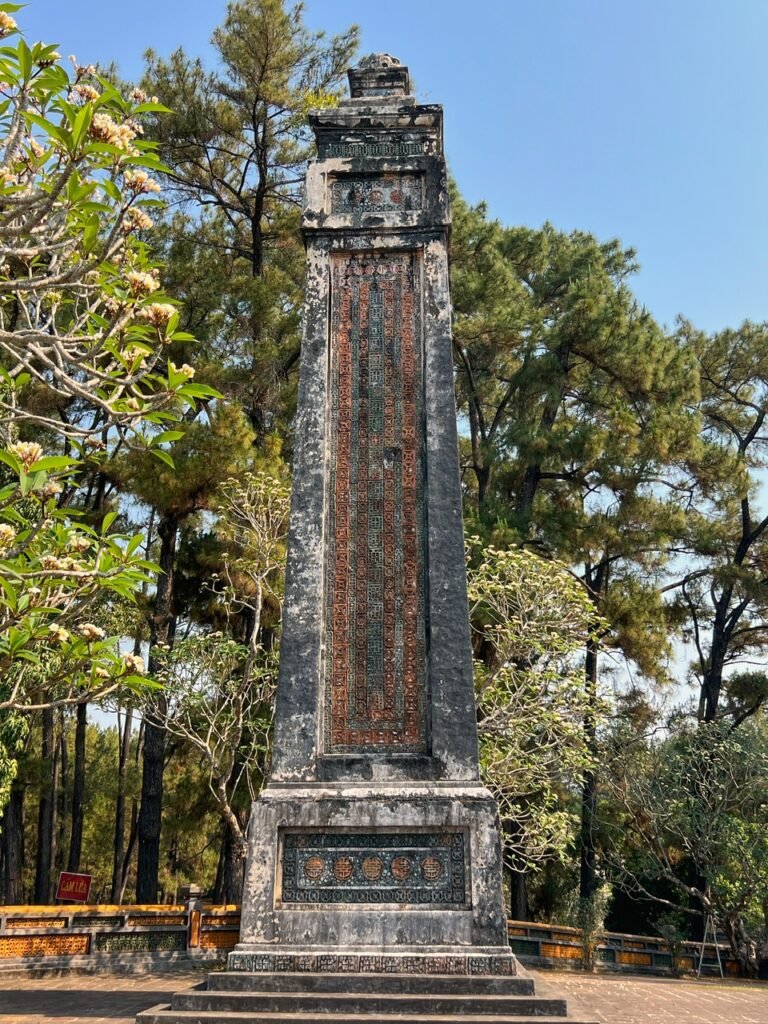

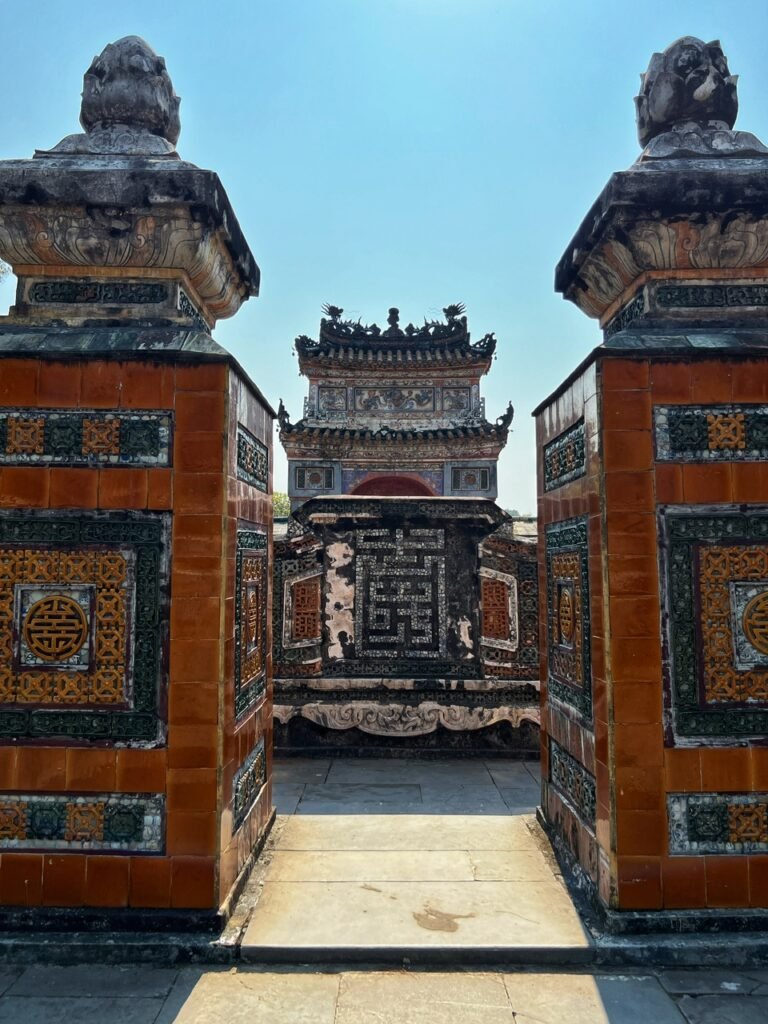

On the walk to the tomb itself, stone elephants and horses guard the entrance, and more details of the tomb itself…
One Week: Life in Hue
Life in Hue for a week was…absolutely oppressive…during the heat wave that swept SE Asia over the time we were there. Unfortunately this led to us not seeing or enjoying the city as much as we probably would have otherwise because we made it a concerted effort to stay inside from 10 am-4 pm. (Although there were plenty of crazy tourists out riding their bikes at noon.)
Still…during the mornings and evenings, we were able to escape our A/C den and soak in a few things the city has to offer.
That said, we don’t think the city of half million is an alternative to Hoi An as one magazine article we read suggested. It does, as indicated in previous photos, have a fascinating royal history, a diverse and radically unique cuisine, and some more peaceful places to walk, although we’d say in the majority of places you’re simply trying not to become motorbike road kill. (much like the rest of Vietnam cities we’ve visited.)
Maybe our experience was just jaded, or we were simply ready to get out of the city, but all in all we’d say we liked it…but didn’t love it….

Hue has the infamously picky eater, Emperor Tu Duc, to thank for their wide breadth of regional dishes. One of the most notable is “royal rice cakes.” Vegetarian food has a long tradition in the city as well so this also is not an issue.

Flags were prevalent in Hue, most likely leading up to the April 30 Reunification Day holiday, the day that marks the event when the North Vietnamese/Viet Cong captured Saigon, ending the American (Vietnam) War in 1975.

A sampling of the unique architecture in Hue.

One of the main streets in the tourist area

Hue also offers a plethora or knock-off shopping. This store had a wide array of North Face, Fjallraven, Adidas and Columbia goods at rock bottom prices.

Peace signs are out and finger hearts are in. Oftentimes in Vietnam we’ve seen kids displaying this gesture to us. They were usually smiling so we didn’t think it was vulgar but finally confirmed what it means. It was popularized by K-pop idols, who would often use the gesture to express their love and gratitude to their fans.

Contrary to what it looks like, Greg is not selling his services at the Nook Eatery.

Dragon boats dot the waterfront along the Perfume River. According to Encounters Travel, “the name originates from the flowers that grow in orchards upriver from the city of Hue. These flowers, known for their sweet-smelling fragrance, often fall into the river, creating a subtle and pleasant aroma that wafts along the water’s surface.”

Is it possible to build a normal bridge in Vietnam? They all seem like they have to “do” something. 🤣


The pedestrian-friendly paths run along each side of the river which was a nice place for a cool 100 degree evening stroll. Alongside, you’ll see lots of Vietnamese garbage carts. Everything is certainly clean!
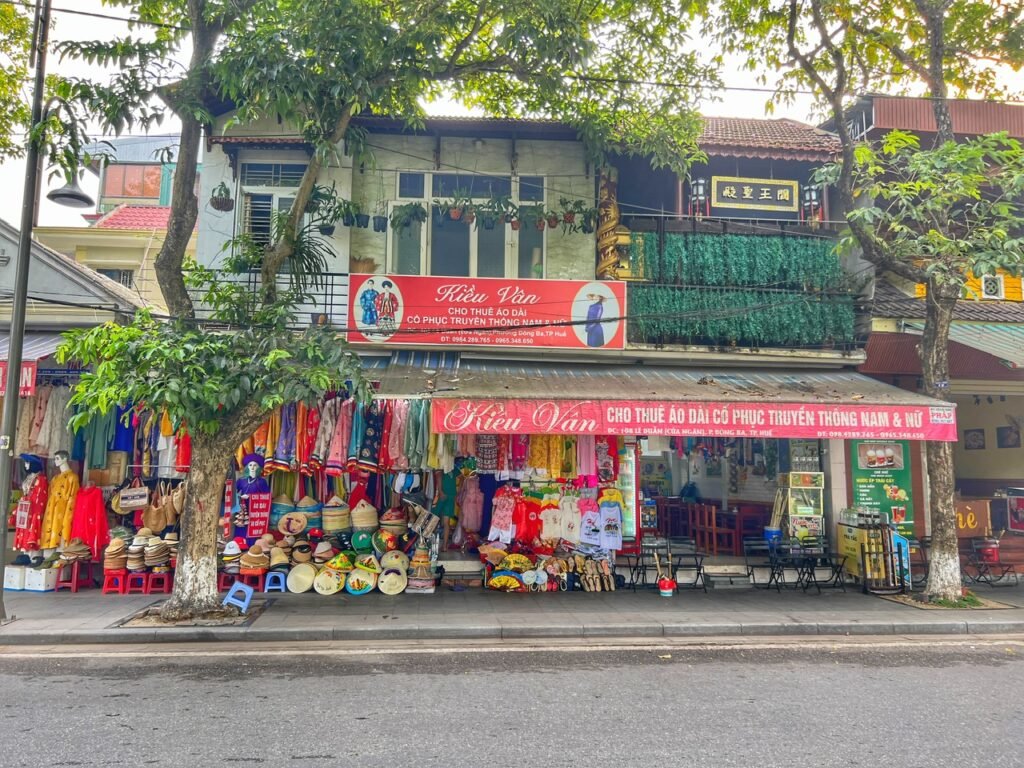
If you’re going to buy a conical hat, its hometown of Hue is apparently the place to do it. It was here girls from Tay Ho learned to make them at a very young age and here they also add their favorite lines of poetry.

At Cozy Restaurant we ordered some of the Hue’s famous savory royal rice cakes, called Banh Bèo which were topped with shrimp, spring onion and finished with fish sauce. ~$1.55

Here we also met up with Jeff, a fellow nomad whose passion is thru hiking, who openly (positively 😅) judged us for our shoe choice. As hikers ourselves, were incredibly fascinated to hear about his accomplishments of hiking the Pacific Coast Trail from Mexico to Canada and Transcaucasian Trail (Georgia and Armenia). What a great meetup!


Another night we checked out Madame Thu’s a highly rated restaurant in Hue. There is a more local feeling one called Madam Thu’s number one and another more uppity western one, number two. Both are probably great but we went with the first.
This is where we shared the “taste of Hue” sampler from the first photo for about $7.50. It was an amazing way to try all the different local delicacies. YUM!!!


Inside the banana leaf you could find a Nam Cake, made of rice flour, shrimp, wrapped in leaves and served with fish sauce. Mandy also had a tofu veggie noodle dish with spicy peanut sauce for about $1.
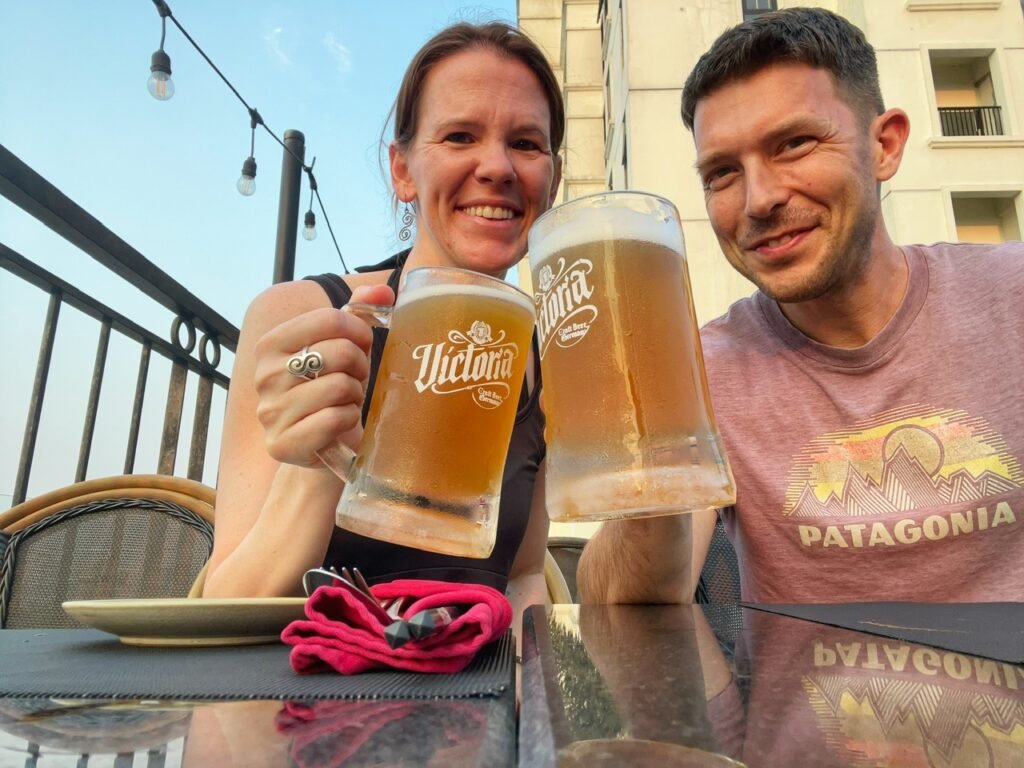
A cheers at Victoria Brewing near our apartment that we were about to escape the cities…and the heat. Three craft beers were about $5, regular pricing.


Following her family Sunday gathering, our sweet host Trang brought us food again! Wow! What a gem. Using the vermicelli noodles, vegan bun chay (tofu vegetable soup), green toppings and pork belly, for Greg, we assembled our soups! It was absolutely delicious. Far better than Grab delivery 🤣

Looking at France outside our balcony. The yellow vintage car really completed the photo.

Like in Europe, it Hue it’s common to find restaurants tucked into ancient royal gates.
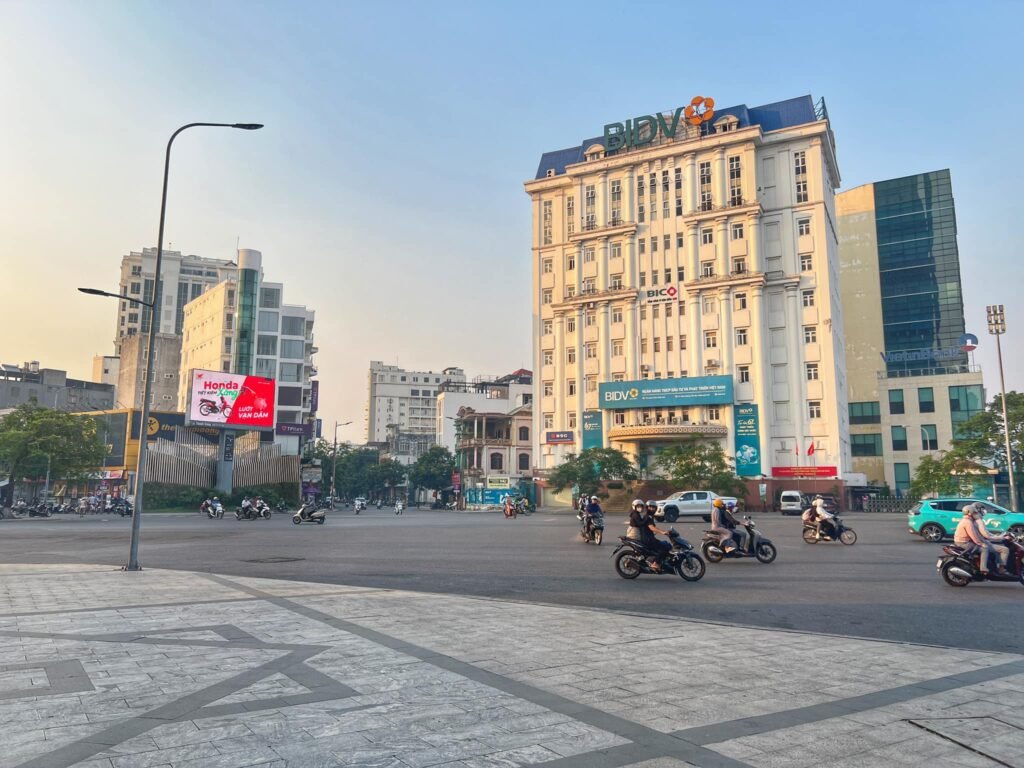
A very busy intersection in Hue also offers some French-ness.

